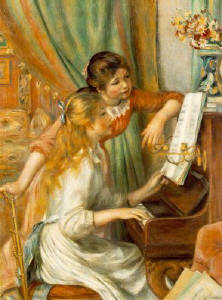
Title: The French Impressionists (1860-1900)
Author: Camille Mauclair
Translator: Paul G. Konody
Release date: November 15, 2004 [eBook #14056]
Most recently updated: December 18, 2020
Language: English
Credits: E-text prepared by Juliet Sutherland, Linda Cantoni, and the Project Gutenberg Online Distributed Proofreading Team
E-text prepared by Juliet Sutherland, Linda Cantoni,
and the Project Gutenberg Online Distributed Proofreading Team
AUTHOR OF L'ART EN SILENCE, LES MÈRES SOCIALES, ETC.

I. THE PRECURSORS OF IMPRESSIONISM—THE BEGINNING OF THIS MOVEMENT, THE ORIGIN OF ITS NAME
III. EDOUARD MANET: HIS WORK, HIS INFLUENCE
IV. EDGAR DEGAS: HIS WORK, HIS INFLUENCE
V. CLAUDE MONET: HIS WORK, HIS INFLUENCE
VI. AUGUSTE RENOIR: HIS WORK, HIS INFLUENCE
It should be stated here that, with the exception of one reproduction after the Neo-Impressionist Van Rysselberghe, the other forty-nine engravings illustrating this volume I owe to the courtesy of M. Durand-Ruel, from the first the friend of the Impressionist painters, and later the most important collector of their works, a friend who has been good enough to place at our disposal the photographs from which our illustrations have been reproduced. Chosen from a considerable collection which has been formed for thirty years past, these photographs, none of which are for sale, form a veritable and unique museum of documents on Impressionist art, which is made even more valuable through the dispersal of the principal masterpieces of this art among the private collections of Europe and America. We render our thanks to M. Durand-Ruel no less in the name of the public interested in art, than in our own.
MANET. Young Man in Costume of Majo
DEGAS. The Dancer at the Photographer's
CLAUDE MONET. Church at Vernon
RENOIR. Portrait of Madame Maitre
MANET. The Woman with the Parrot
MANET. The Bar at the Folies-Bergère
MANET. Portrait of Madame M.L.
DEGAS. The Lesson in the Foyer
DEGAS. The Dancing Lesson—Pastel
CLAUDE MONET. An Interior after Dinner
CLAUDE MONET. The Harbour, Honfleur
CLAUDE MONET. The Church at Varengeville
CLAUDE MONET. Poplars on the Epte in Autumn
CLAUDE MONET. The Bridge at Argenteuil
RENOIR. Young Girl Promenading
RENOIR. Young Woman in Empire Costume
PISSARRO. Rue de l'Epicerie, Rouen
PISSARRO. Boulevard Montmartre
PISSARRO. The Boildieaux Bridge at Rouen
PISSARRO. The Avenue de l'Opéra
SISLEY. Bougival, at the Water's Edge
BERTHE MORISOT. Young Woman Seated
THÉO VAN RYSSELBERGHE. Portraits of Madame van Rysselberghe and her Daughter
The illustrations contained in this volume have been taken from different epochs of the Impressionist movement. They will give but a feeble idea of the extreme abundance of its production.
Banished from the salons, exhibited in private galleries and sold direct to art lovers, the Impressionist works have been but little seen. The series left by Caillebotte to the Luxembourg Gallery is very badly shown and is composed of interesting works which, however, date back to the early period, and are very inferior to the beautiful productions which followed later. Renoir is best represented. The private galleries in Paris, where the best Impressionist works are to be found, are those of MM. Durand-Ruel, Rouart, de Bellis, de Camondo, and Manzi, to which must be added the one sold by MM. Théodore Duret and Faure, and the one of Mme. Ernest Rouart, daughter of Mme. Morisot, the sister-in-law of Manet. The public galleries of M. Durand-Ruel's show-rooms are the place where it is easiest to find numerous Impressionist pictures.
In spite of the firm opposition of the official juries, a place of honour was reserved at the Exposition of 1889 for Manet, and at that of 1900 a fine collection of Impressionists occupied two rooms and caused a considerable stir.
Amongst the critics who have most faithfully assisted this group of artists, I must mention, besides the early friends previously referred to, Castagnary, Burty, Edouard de Goncourt, Roger Marx, Geffroy, Arsène Alexandre, Octave Mirbeau, L. de Fourcaud, Clemenceau, Mallarmé, Huysmans, Jules Laforgue, and nearly all the critics of the Symbolist reviews. A book on "Impressionist Art" by M. Georges Lecomte has been published by the firm of Durand-Ruel as an edition-de-luxe. But the bibliography of this art consists as yet almost exclusively of articles in journals and reviews and of some isolated biographical pamphlets. Manet is, amongst many, the one who has excited most criticism of all kinds; the articles, caricatures and pamphlets relating to his work would form a considerable collection. It should be added that, with the exception of Manet two years before his death, and Renoir last year at the age of sixty-eight, no Impressionist has been decorated by the French government. In England such a distinction has even less importance in itself than elsewhere. But if I insist upon it, it is only to draw attention to the fact that, through the sheer force of their talent, men like Degas, Monet and Pissarro have achieved great fame and fortune, without gaining access to the Salons, without official encouragement, decoration, subvention or purchases for the national museums. This is a very significant instance and serves well to complete the physiognomy of this group of independents.
It will be beyond the scope of this volume to give a complete history of French Impressionism, and to include all the attractive details to which it might lead, as regards the movement itself and the very curious epoch during which its evolution has taken place. The proportions of this book confine its aim to the clearest possible summing up for the British reader of the ideas, the personalities and the works of a considerable group of artists who, for various reasons, have remained but little known and who have only too frequently been gravely misjudged. These reasons are very obvious: first, the Impressionists have been unable to make a show at the Salons, partly because the jury refused them admission, partly because they held aloof of their own free will. They have, with very rare exceptions, exhibited at special minor galleries, where they become known to a very restricted public. Ever attacked, and poor until the last few years, they enjoyed none of the benefits of publicity and sham glory. It is only quite recently that the admission of the incomplete and badly arranged Caillebotte collection to the Luxembourg Gallery has enabled the public to form a summary idea of Impressionism. To conclude the enumeration of the obstacles, it must be added that there are hardly any photographs of Impressionist works in the market. As it is, photography is but a poor translation of these canvases devoted to the study of the play of light; but even this very feeble means of distribution has been withheld from them! Exhibited at some galleries, gathered principally by Durand-Ruel, sold directly to art-lovers—foreigners mostly—these large series of works have practically remained unknown to the French public. All the public heard was the reproaches and sarcastic comments of the opponents, and they never became aware that in the midst of modern life the greatest, the richest movement was in progress, which the French school had known since the days of Romanticism. Impressionism has been made known to them principally by the controversies and by the fruitful consequences of this movement for the illustration and study of contemporary life.
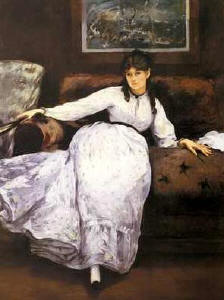
I do not profess to give here a detailed and complete history of Impressionism, for which several volumes like the present one would be required. I shall only try to compile an ensemble of concise and very precise notions and statements bearing upon this vast subject. It will be my special object to try and prove that Impressionism is neither an isolated manifestation, nor a violent denial of the French traditions, but nothing more or less than a logical return to the very spirit of these traditions, contrary to the theories upheld by its detractors. It is for this reason that I have made use of the first chapter to say a few words on the precursors of this movement.
No art manifestation is really isolated. However new it may seem, it is always based upon the previous epochs. The true masters do not give lessons, because art cannot be taught, but they set the example. To admire them does not mean to imitate them: it means the recognition in them of the principles of originality and the comprehension of their source, so that this eternal source may be called to life in oneself, this source which springs from a sincere and sympathetic vision of the aspects of life. The Impressionists have not escaped this beautiful law. I shall speak of them impartially, without excessive enthusiasm; and it will be my special endeavour to demonstrate in each of them the cult of a predecessor, for there have been few artistic movements where the love for, and one might say the hereditary link with, the preceding masters has been more tenacious.
The Academy has struggled violently against Impressionism, accusing it of madness, of systematic negation of the "laws of beauty," which it pretended to defend and of which it claimed to be the official priest. The Academy has shown itself hostile to a degree in this quarrel. It has excluded the Impressionists from the Salons, from awards, from official purchases. Only quite recently the acceptance of the Caillebotte bequest to the Luxembourg Gallery gave rise to a storm of indignation among the official painters. I shall, in the course of this book, enter upon the value of these attacks. Meanwhile I can only say how regrettable this obstinacy appears to me and will appear to every free spirit. It is unworthy even of an ardent conviction to condemn a whole group of artists en bloc as fools, enemies of beauty, or as tricksters anxious to degrade the art of their nation, when these artists worked during forty years towards the same goal, without getting any reward for their effort, but poverty and derision. It is now about ten years since Impressionism has taken root, since its followers can sell their canvases, and since they are admired and praised by a solid and ever-growing section of the public. The hour has therefore arrived, calmly to consider a movement which has imposed itself upon the history of French art from 1860 to 1900 with extreme energy, to leave dithyrambics as well as polemics, and to speak of it with a view to exactness. The Academy, in continuing the propagation of an ideal of beauty fixed by canons derived from Greek, Latin and Renaissance art, and neglecting the Gothic, the Primitives and the Realists, looks upon itself as the guardian of the national tradition, because it exercises an hierarchic authority over the Ecole de Rome, the Salons, and the Ecole des Beaux Arts. All the same, its ideals are of very mixed origin and very little French. Its principles are the same by which the academic art of nearly all the official schools of Europe is governed. This mythological and allegorical art, guided by dogmas and formulas which are imposed upon all pupils regardless of their temperament, is far more international than national. To an impartial critic this statement will show in an even more curious light the excommunication jealously issued by the academic painters against French artists, who, far from revolting in an absurd spirit of parti-pris against the genius of their race, are perhaps more sincerely attached to it than their persecutors. Why should a group of men deliberately choose to paint mad, illogical, bad pictures, and reap a harvest of public derision, poverty and sterility? It would be uncritical to believe merely in a general mystification which makes its authors the worst sufferers. Simple common sense will find in these men a conviction, a sincerity, a sustained effort, and this alone should, in the name of the sacred solidarity of those who by various means try to express their love of the beautiful, suppress the annoying accusations hurled too light-heartedly against Manet and his friends.
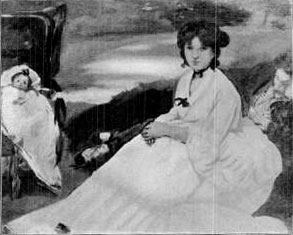
I shall define later on the ideas of the Impressionists on technique, composition and style in painting. Meanwhile it will be necessary to indicate their principal precursors.
Their movement may be styled thus: a reaction against the Greco-Latin spirit and the scholastic organisation of painting after the second Renaissance and the Italo-French school of Fontainebleau, by the century of Louis XIV., the school of Rome, and the consular and imperial taste. In this sense Impressionism is a protest analogous to that of Romanticism, exclaiming, to quote the old verse: "Qui nous délivrera des Grecs et des Romains?"1 From this point of view Impressionism has also great affinities with the ideas of the English Pre-Raphaelites, who stepped across the second and even the first Renaissance back to the Primitives.
This reaction is superimposed by another: the reaction of Impressionism, not only against classic subjects, but against the black painting of the degenerate Romanticists. And these two reactions are counterbalanced by a return to the French ideal, to the realistic and characteristic tradition which commences with Jean Foucquet and Clouet, and is continued by Chardin, Claude Lorrain, Poussin, Watteau, La Tour, Fragonard, and the admirable engravers of the eighteenth century down to the final triumph of the allegorical taste of the Roman revolution. Here can be found a whole chain of truly national artists who have either been misjudged, like Chardin, or considered as "small masters" and excluded from the first rank for the benefit of the pompous Allegorists descended from the Italian school.
Impressionism being beyond all a technical reaction, its predecessors should first be looked for from this material point of view. Watteau is the most striking of all. L'Embarquement pour Cythère is, in its technique, an Impressionist canvas. It embodies the most significant of all the principles exposed by Claude Monet: the division of tones by juxtaposed touches of colour which, at a certain distance, produce upon the eye of the beholder the effect of the actual colouring of the things painted, with a variety, a freshness and a delicacy of analysis unobtainable by a single tone prepared and mixed upon the palette.
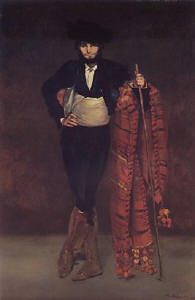
Claude Lorrain, and after him Carle Vernet, are claimed by the Impressionists as precursors from the point of view of decorative landscape arrangement, and particularly of the predominance of light in which all objects are bathed. Ruysdael and Poussin are, in their eyes, for the same reasons precursors, especially Ruysdael, who observed so frankly the blue colouring of the horizon and the influence of blue upon the landscape. It is known that Turner worshipped Claude for the very same reasons. The Impressionists in their turn, consider Turner as one of their masters; they have the greatest admiration for this mighty genius, this sumptuous visionary. They have it equally for Bonington, whose technique is inspired by the same observations as their own. They find, finally, in Delacroix the frequent and very apparent application of their ideas. Notably in the famous Entry of the Crusaders into Constantinople, the fair woman kneeling in the foreground is painted in accordance with the principles of the division of tones: the nude back is furrowed with blue, green and yellow touches, the juxtaposition of which produces, at a certain distance, an admirable flesh-tone.
And now I must speak at some length of a painter who, together with the luminous and sparkling landscapist Félix Ziem, was the most direct initiator of Impressionist technique. Monticelli is one of those singular men of genius who are not connected with any school, and whose work is an inexhaustible source of applications. He lived at Marseilles, where he was born, made a short appearance at the Salons, and then returned to his native town, where he died poor, ignored, paralysed and mad. In order to live he sold his small pictures at the cafés, where they fetched ten or twenty francs at the most. To-day they sell for considerable prices, although the government has not yet acquired any work by Monticelli for the public galleries. The mysterious power alone of these paintings secures him a fame which is, alas! posthumous. Many Monticellis have been sold by dealers as Diaz's; now they are more eagerly looked for than Diaz, and collectors have made fortunes with these small canvases bought formerly, to use a colloquial expression which is here only too literally true, "for a piece of bread."
Monticelli painted landscapes, romantic scenes, "fêtes galantes" in the spirit of Watteau, and still-life pictures: one could not imagine a more inspired sense of colour than shown by these works which seem to be painted with crushed jewels, with powerful harmony, and beyond all with an unheard-of delicacy in the perception of fine shades. There are tones which nobody had ever invented yet, a richness, a profusion, a subtlety which almost vie with the resources of music. The fairyland atmosphere of these works surrounds a very firm design of charming style, but, to use the words of the artist himself, "in these canvases the objects are the decoration, the touches are the scales, and the light is the tenor." Monticelli has created for himself an entirely personal technique which can only be compared with that of Turner; he painted with a brush so full, fat and rich, that some of the details are often truly modelled in relief, in a substance as precious as enamels, jewels, ceramics—a substance which is a delight in itself. Every picture by Monticelli provokes astonishment; constructed upon one colour as upon a musical theme, it rises to intensities which one would have thought impossible. His pictures are magnificent bouquets, bursts of joy and colour, where nothing is ever crude, and where everything is ruled by a supreme sense of harmony.
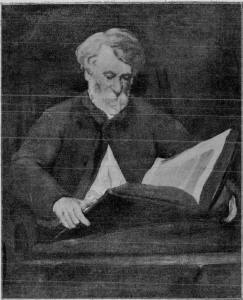
Claude Lorrain, Watteau, Turner and Monticelli constitute really the descent of a landscapist like Claude Monet. In all matters concerning technique, they form the direct chain of Impressionism. As regards design, subject, realism, the study of modern life, the conception of beauty and the portrait, the Impressionist movement is based upon the old French masters, principally upon Chardin, Watteau, Latour, Largillière, Fragonard, Debucourt, Saint-Aubin, Moreau, and Eisen. It has resolutely held aloof from mythology, academic allegory, historical painting, and from the neo-Greek elements of Classicism as well as from the German and Spanish elements of Romanticism. This reactionary movement is therefore entirely French, and surely if it deserves reproach, the one least deserved is that levelled upon it by the official painters: disobedience to the national spirit. Impressionism is an art which does not give much scope to intellectuality, an art whose followers admit scarcely anything but immediate vision, rejecting philosophy and symbols and occupying themselves only with the consideration of light, picturesqueness, keen and clever observation, and antipathy to abstraction, as the innate qualities of French art. We shall see later on, when considering separately its principal masters, that each of them has based his art upon some masters of pure French blood.
Impressionism has, then, hitherto been very badly judged. It is contained in two chief points: search after a new technique, and expression of modern reality. Its birth has not been a spontaneous phenomenon. Manet, who, by his spirit and by the chance of his friendships, grouped around him the principal members, commenced by being classed in the ranks of the Realists of the second Romanticism by the side of Courbet; and during the whole first period of his work he only endeavoured to describe contemporary scenes, at a time when the laws of the new technique were already dawning upon Claude Monet. Gradually the grouping of the Impressionists took place. Claude Monet is really the first initiator: in a parallel line with his ideas and his works Manet passed into the second period of his artistic life, and with him Renoir, Degas and Pissarro. But Manet had already during his first period been the topic of far-echoing polemics, caused by his realism and by the marked influence of the Spaniards and of Hals upon his style; his temperament, too, was that of the head of a school; and for these reasons legend has attached to his name the title of head of the Impressionist school, but this legend is incorrect.
To conclude, the very name "Impressionism" is due to Claude Monet. There has been much serious arguing upon this famous word which has given rise to all sorts of definitions and conclusions. In reality this is its curious origin which is little known, even in criticism. Ever since 1860 the works of Manet and of his friends caused such a stir, that they were rejected en bloc by the Salon jury of 1863. The emperor, inspired by a praiseworthy, liberal thought, demanded that these innovators should at least have the right to exhibit together in a special room which was called the Salon des Refusés. The public crowded there to have a good laugh. One of the pictures which caused most derision was a sunset by Claude Monet, entitled Impressions. From this moment the painters who adopted more or less the same manner were called Impressionists. The word remained in use, and Manet and his friends thought it a matter of indifference whether this label was attached to them, or another. At this despised Salon were to be found the names of Manet, Monet, Whistler, Bracquemont, Jongkind, Fantin-Latour, Renoir, Legros, and many others who have since risen to fame. Universal ridicule only fortified the friendships and resolutions of this group of men, and from that time dates the definite foundation of the Impressionist school. For thirty years it continued to produce without interruption an enormous quantity of works under an accidental and inexact denomination; to obey the creative instinct, without any other dogma than the passionate observation of nature, without any other assistance than individual sympathies, in the face of the disciplinary teaching of the official school.
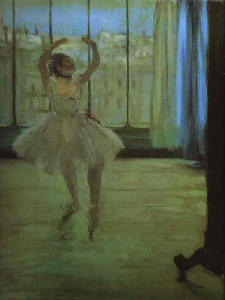
It should be stated from the outset that there is nothing dogmatic about this explanation of the Impressionist theories, and that it is not the result of a preconceived plan. In art a system is not improvised. A theory is slowly evolved, nearly always unknown to the author, from the discoveries of his sincere instinct, and this theory can only be formulated after years by criticism facing the works. Monet and Manet have worked for a long time without ever thinking that theories would be built upon their paintings. Yet a certain number of considerations will strike the close observer, and I will put these considerations before the reader, after reminding him that spontaneity and feeling are the essentials of all art.
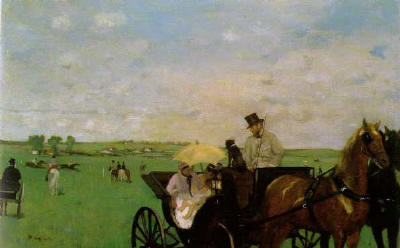
The Impressionist ideas may be summed up in the following manner:—
In nature no colour exists by itself. The colouring of the objects is a pure illusion: the only creative source of colour is the sunlight which envelopes all things, and reveals them, according to the hours, with infinite modifications. The mystery of matter escapes us; we do not know the exact moment when reality separates itself from unreality. All we know is, that our vision has formed the habit of discerning in the universe two notions: form and colour; but these two notions are inseparable. Only artificially can we distinguish between outline and colour: in nature the distinction does not exist. Light reveals the forms, and, playing upon the different states of matter, the substance of leaves, the grain of stones, the fluidity of air in deep layers, gives them dissimilar colouring. If the light disappears, forms and colours vanish together. We only see colours; everything has a colour, and it is by the perception of the different colour surfaces striking our eyes, that we conceive the forms, i.e. the outlines of these colours.
The idea of distance, of perspective, of volume is given us by darker or lighter colours: this idea is what is called in painting the sense of values. A value is the degree of dark or light intensity, which permits our eyes to comprehend that one object is further or nearer than another. And as painting is not and cannot be the imitation of nature, but merely her artificial interpretation, since it only has at its disposal two out of three dimensions, the values are the only means that remain for expressing depth on a flat surface.
Colour is therefore the procreatrix of design. Or, colour being simply the irradiation of light, it follows that all colour is composed of the same elements as sunlight, namely the seven tones of the spectrum. It is known, that these seven tones appear different owing to the unequal speed of the waves of light. The tones of nature appear to us therefore different, like those of the spectrum, and for the same reason. The colours vary with the intensity of light. There is no colour peculiar to any object, but only more or less rapid vibration of light upon its surface. The speed depends, as is demonstrated by optics, on the degree of the inclination of the rays which, according to their vertical or oblique direction, give different light and colour.
The colours of the spectrum are thus recomposed in everything we see. It is their relative proportion which makes new tones out of the seven spectral tones. This leads immediately to some practical conclusions, the first of which is, that what has formerly been called local colour is an error: a leaf is not green, a tree-trunk is not brown, and, according to the time of day, i.e. according to the greater or smaller inclination of the rays (scientifically called the angle of incidence), the green of the leaf and the brown of the tree are modified. What has to be studied therefore in these objects, if one wishes to recall their colour to the beholder of a picture, is the composition of the atmosphere which separates them from the eye. This atmosphere is the real subject of the picture, and whatever is represented upon it only exists through its medium.
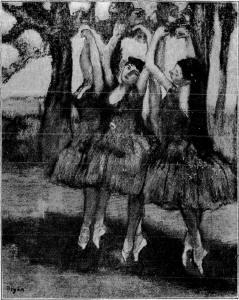
A second consequence of this analysis of light is, that shadow is not absence of light, but light of a different quality and of different value. Shadow is not a part of the landscape, where light ceases, but where it is subordinated to a light which appears to us more intense. In the shadow the rays of the spectrum vibrate with different speed. Painting should therefore try to discover here, as in the light parts, the play of the atoms of solar light, instead of representing shadows with ready-made tones composed of bitumen and black.
The third conclusion resulting from this: the colours in the shadow are modified by refraction. That means, f.i. in a picture representing an interior, the source of light (window) may not be indicated: the light circling round the picture will then be composed of the reflections of rays whose source is invisible, and all the objects, acting as mirrors for these reflections, will consequently influence each other. Their colours will affect each other, even if the surfaces be dull. A red vase placed upon a blue carpet will lead to a very subtle, but mathematically exact, interchange between this blue and this red, and this exchange of luminous waves will create between the two colours a tone of reflections composed of both. These composite reflections will form a scale of tones complementary of the two principal colours. The science of optics can work out these complementary colours with mathematical exactness. If f.i. a head receives the orange rays of daylight from one side and the bluish light of an interior from the other, green reflections will necessarily appear on the nose and in the middle region of the face. The painter Besnard, who has specially devoted himself to this minute study of complementary colours, has given us some famous examples of it.
The last consequence of these propositions is that the blending of the spectral tones is accomplished by a parallel and distinct projection of the colours. They are artificially reunited on the crystalline: a lens interposed between the light and the eye, and opposing the crystalline, which is a living lens, dissociates again these united rays, and shows us again the seven distinct colours of the atmosphere. It is no less artificial if a painter mixes upon his palette different colours to compose a tone; it is again artificial that paints have been invented which represent some of the combinations of the spectrum, just to save the artist the trouble of constantly mixing the seven solar tones. Such mixtures are false, and they have the disadvantage of creating heavy tonalities, since the coarse mixture of powders and oils cannot accomplish the action of light which reunites the luminous waves into an intense white of unimpaired transparency. The colours mixed on the palette compose a dirty grey. What, then, is the painter to do, who is anxious to approach, as near as our poor human means will allow, that divine fairyland of nature? Here we touch upon the very foundations of Impressionism. The painter will have to paint with only the seven colours of the spectrum, and discard all the others: that is what Claude Monet has done boldly, adding to them only white and black. He will, furthermore, instead of composing mixtures on his palette, place upon his canvas touches of none but the seven colours juxtaposed, and leave the individual rays of each of these colours to blend at a certain distance, so as to act like sunlight itself upon the eye of the beholder.
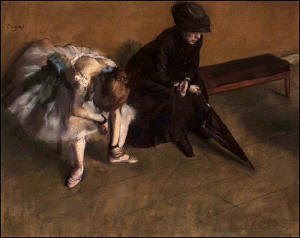
This, then, is the theory of the dissociation of tones, which is the main point of Impressionist technique. It has the immense advantage of suppressing all mixtures, of leaving to each colour its proper strength, and consequently its freshness and brilliancy. At the same time the difficulties are extreme. The painter's eye must be admirably subtle. Light becomes the sole subject of the picture; the interest of the object upon which it plays is secondary. Painting thus conceived becomes a purely optic art, a search for harmonies, a sort of natural poem, quite distinct from expression, style and design, which were the principal aims of former painting. It is almost necessary to invent another name for this special art which, clearly pictorial though it be, comes as near to music, as it gets far away from literature and psychology. It is only natural that, fascinated by this study, the Impressionists have almost remained strangers to the painting of expression, and altogether hostile to historical and symbolist painting. It is therefore principally in landscape painting that they have achieved the greatness that is theirs.
Through the application of these principles which I have set forth very summarily, Claude Monet arrived at painting by means of the infinitely varied juxtaposition of a quantity of colour spots which dissociate the tones of the spectrum and draw the forms of objects through the arabesque of their vibrations. A landscape thus conceived becomes a kind of symphony, starting from one theme (the most luminous point, f.i.), and developing all over the canvas the variations of this theme. This investigation is added to the habitual preoccupations of the landscapist study of the character peculiar to the scene, style of the trees or houses, accentuation of the decorative side—and to the habitual preoccupations of the figure painter in the portrait. The canvases of Monet, Renoir and Pissarro have, in consequence of this research, an absolutely original aspect: their shadows are striped with blue, rose-madder and green; nothing is opaque or sooty; a light vibration strikes the eye. Finally, blue and orange predominate, simply because in these studies—which are more often than not full sunlight effects—blue is the complementary colour of the orange light of the sun, and is profusely distributed in the shadows. In these canvases can be found a vast amount of exact grades of tone, which seem to have been entirely ignored by the older painters, whose principal concern was style, and who reduced a landscape to three or four broad tones, endeavouring only to explain the sentiment inspired by it.
And now I shall have to pass on to the Impressionists' ideas on the style itself of painting, on Realism.
From the outset it must not be forgotten that Impressionism has been propagated by men who had all been Realists; that means by a reactionary movement against classic and romantic painting. This movement, of which Courbet will always remain the most famous representative, has been anti-intellectual. It has protested against every literary, psychologic or symbolical element in painting. It has reacted at the same time against the historical painting of Delaroche and the mythological painting of the Ecole de Rome, with an extreme violence which appears to us excessive now, but which found its explanation in the intolerable tediousness or emphasis at which the official painters had arrived. Courbet was a magnificent worker, with rudimentary ideas, and he endeavoured to exclude even those which he possessed. This exaggeration which diminishes our admiration for his work and prevents us from finding in it any emotion but that which results from technical mastery, was salutary for the development of the art of his successors. It caused the young painters to turn resolutely towards the aspects of contemporary life, and to draw style and emotion from their own epoch; and this intention was right. An artistic tradition is not continued by imitating the style of the past, but by extracting the immediate impression of each epoch. That is what the really great masters have done, and it is the succession of their sincere and profound observations which constitutes the style of the races.
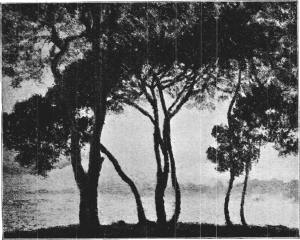
Manet and his friends drew all their strength from this idea. Much finer and more learned than a man like Courbet, they saw an aspect of modernity far more complex, and less limited to immediate and grossly superficial realism. Nor must it be forgotten that they were contemporaries of the realistic, anti-romantic literary movement, a movement which gave them nothing but friends. Flaubert and the Goncourts proved that Realism is not the enemy of refined form and of delicate psychology. The influence of these ideas created first of all Manet and his friends: the technical evolution (of which we have traced the chief traits) came only much later to oppose itself to their conceptions. Impressionism can therefore be defined as a revolution of pictorial technique together with an attempt at expressing modernity. The reaction against Symbolism and Romanticism happened to coincide with the reaction against muddy technique.
The Impressionists, whilst occupying themselves with cleansing the palette of the bitumen of which the Academy made exaggerated use, whilst also observing nature with a greater love of light, made it their object to escape in the representation of human beings the laws of beauty, such as were taught by the School. And on this point one might apply to them all that one knows of the ideas of the Goncourts and Flaubert, and later of Zola, in the domain of the novel. They were moved by the same ideas; to speak of the one group is to speak of the other. The longing for truth, the horror of emphasis and of false idealism which paralysed the novelist as well as the painter, led the Impressionists to substitute for beauty a novel notion, that of character. To search for, and to express, the true character of a being or of a site, seemed to them more significant, more moving, than to search for an exclusive beauty, based upon rules, and inspired by the Greco-Latin ideal. Like the Flemings, the Germans, the Spaniards, and in opposition to the Italians whose influence had conquered all the European academies, the French Realist-Impressionists, relying upon the qualities of lightness, sincerity and expressive clearness which are the real merits of their race, detached themselves from the oppressive and narrow preoccupation with the beautiful and with all the metaphysics and abstractions following in its train.
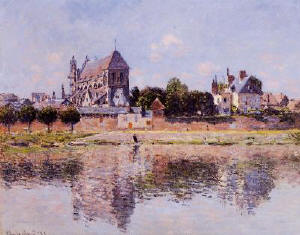
This fact of the substitution of character for beauty is the essential feature of the movement. What is called Impressionism is—let it not be forgotten—a technique which can be applied to any subject. Whether the subject be a virgin, or a labourer, it can be painted with divided tones, and certain living artists, like the symbolist Henri Martin, who has almost the ideas of a Pre-Raphaelite, have proved it by employing this technique for the rendering of religious or philosophic subjects. But one can only understand the effort and the faults of the painters grouped around Manet, by constantly recalling to one's mind their predeliction for character. Before Manet a distinction was made between noble subjects, and others which were relegated to the domain of genre in which no great artist was admitted to exist by the School, the familiarity of their subjects barring from them this rank. By the suppression of the nobleness inherent to the treated subject, the painter's technical merit is one of the first things to be considered in giving him rank. The Realist-Impressionists painted scenes in the ball-room, on the river, in the field, the street, the foundry, modern interiors, and found in the life of the humble immense scope for studying the gestures, the costumes, the expressions of the nineteenth century.
Their effort had its bearing upon the way of representing persons, upon what is called, in the studio language, the "mise en cadre." There, too, they overthrew the principles admitted by the School. Manet, and especially Degas, have created in this respect a new style from which the whole art of realistic contemporary illustration is derived. This style had been hitherto totally ignored, or the artists had shrunk from applying it. It is a style which is founded upon the small painters of the eighteenth century, upon Saint-Aubin, Debucourt, Moreau, and, further back, upon Pater and the Dutchmen. But this time, instead of confining this style to vignettes and very small dimensions, the Impressionists have boldly given it the dimensions and importance of big canvases. They have no longer based the laws of composition, and consequently of style, upon the ideas relative to the subjects, but upon values and harmonies. To take a summary example: if the School composed a picture representing the death of Agamemnon, it did not fail to subordinate the whole composition to Agamemnon, then to Clytemnestra, then to the witnesses of the murder, graduating the moral and literary interest according to the different persons, and sacrificing to this interest the colouring and the realistic qualities of the scene. The Realists composed by picking out first the strongest "value" of the picture, say a red dress, and then distributing the other values according to a harmonious progression of their tonalities. "The principal person in a picture," said Manet, "is the light." With Manet and his friends we find, then, that the concern for expression and for the sentiments evoked by the subject, was always subordinated to a purely pictorial and decorative preoccupation. This has frequently led the Impressionists to grave errors, which they have, however, generally avoided by confining themselves to very simple subjects, for which the daily life supplied the grouping.
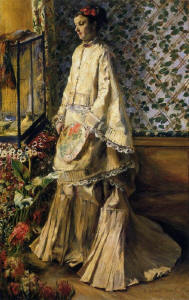
One of the reforms due to their conception has been the suppression of the professional model, and the substitution for it of the natural model, seen in the exercise of his occupation. This is one of the most useful conquests for the benefit of modern painting. It marks a just return to nature and simplicity. Nearly all their figures are real portraits; and in everything that concerns the labourer and the peasant, they have found the proper style and character, because they have observed these beings in the true medium of their occupations, instead of forcing them into a sham pose and painting them in disguise. The basis of all their pictures has been first of all a series of landscape and figure studies made in the open air, far from the studio, and afterwards co-ordinated. One may wish pictorial art to have higher ambitions; and one may find in the Primitives an example of a curious mysticism, an expression of the abstract and of dreams. But one should not underrate the power of naïve and realistic observation, which the Primitives carried into the execution of their works, subordinating it, however, to religious expression, and it must also be admitted that the Realist-Impressionists served at least their conception of art logically and homogeneously. The criticism which may be levelled against them is that which Realism itself carries in its train, and we shall see that esthetics could never create classifications capable of defining and containing the infinite gradations of creative temperaments.
In art, classifications have rarely any value, and are rather damaging. Realism and Idealism are abstract terms which cannot suffice to characterise beings who obey their sensibility. It is therefore necessary to invent as many words as there are remarkable men. If Leonardo was a great painter, are Turner and Monet not painters at all? There is no connection between them; their methods of thought and expression are antithetical. Perhaps it will be most simple, to admire them all, and to renounce any further definition of the painter, adopting this word to mark the man who uses the palette as his means of expression.
Thus preoccupation with contemporary emotions, substitution of character for classic beauty (or of emotional beauty for formal beauty), admission of the genre-painter into the first rank, composition based upon the reciprocal reaction of values, subordination of the subject to the interest of execution, the effort to isolate the art of painting from the ideas inherent to that of literature, and particularly the instinctive move towards the "symphonisation" of colours, and consequently towards music,—these are the principal features of the aesthetic code of the Realist-Impressionists, if this term may be applied to a group of men hostile towards esthetics such as they are generally taught.
As I have said, Edouard Manet has not been entirely the originator of the Impressionist technique. It is the work of Claude Monet which presents the most complete example of it, and which also came first as regards date. But it is very difficult to determine such cases of priority, and it is, after all, rather useless. A technique cannot be invented in a day. In this case it was the result of long investigations, in which Manet and Renoir participated, and it is necessary to unite under the collective name of Impressionists a group of men, tied by friendship, who made a simultaneous effort towards originality, all in about the same spirit, though frequently in very different ways. As in the case of the Pre-Raphaelites, it was first of all friendship, then unjust derision, which created the solidarity of the Impressionists. But the Pre-Raphaelites, in aiming at an idealistic and symbolic art, were better agreed upon the intellectual principles which permitted them at once to define a programme. The Impressionists who were only united by their temperaments, and had made it their first aim to break away from all school programmes, tried simply to do something new, with frankness and freedom.
Manet was, in their midst, the personality marked out at the same time by their admiration, and by the attacks of the critics for the post of standard-bearer. A little older than his friends, he had already, quite alone, raised heated discussions by the works in his first manner. He was considered an innovator, and it was by instinctive admiration that his first friends, Whistler, Legros, and Fantin-Latour, were gradually joined by Marcelin Desboutin, Degas, Renoir, Monet, Pissarro, Caillebotte, Berthe Morisot, the young painter Bazille, who met his premature death in 1870, and by the writers Gautier, Banville, Baudelaire (who was a passionate admirer of Manet's); then later by Zola, the Goncourts, and Stéphane Mallarmé. This was the first nucleus of a public which was to increase year by year. Manet had the personal qualities of a chief; he was a man of spirit, an ardent worker, and an enthusiastic and generous character.
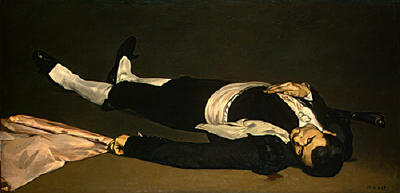
Manet commenced his first studies with Couture. After having travelled a good deal at sea to obey his parents, his vocation took hold of him irresistibly. About 1850 the young man entered the studio of the severe author of the Romains de la Décadence. His stay was short. He displeased the professor by his uncompromising energy. Couture said of him angrily: "He will become the Daumier of 1860." It is known that Daumier, lithographer, and painter of genius, was held in meagre esteem by the academicians. Manet travelled in Germany after the coup d'etat, copied Rembrandt in Munich, then went to Italy, copied Tintoretto in Venice, and conceived there the idea of several religious pictures. Then he became enthusiastic about the Spaniards, especially Velasquez and Goya. The sincere expression of things seen took root from this moment as the principal rule of art in the brain of this young Frenchman who was loyal, ardent, and hostile to all subtleties. He painted some fine works, like the Buveur d'absinthe and the Vieux musicien. They show the influence of Courbet, but already the blacks and the greys have an original and superb quality; they announce a virtuoso of the first order.
It was in 1861 that Manet first sent to the Salon the portraits of his parents and the Guitarero, which was hailed by Gautier, and rewarded by the jury, though it roused surprise and irritation. But after that he was rejected, whether it was a question of the Fifre or of the Déjeuner sur l'herbe. This canvas, with an admirable feminine nude, created a scandal, because an undressed woman figured in it amidst clothed figures, a matter of frequent occurrence with the masters of the Renaissance. The landscape is not painted in the open air, but in the studio, and resembles a tapestry, but it shows already the most brilliant evidence of Manet's talent in the study of the nude and the still-life of the foreground, which is the work of a powerful master. From the time of this canvas the artist's personality appeared in all its maturity. He painted it before he was thirty, and it has the air of an old master's work; it is based upon Hals and the Spaniards together.
The reputation of Manet became established after 1865. Furious critics were opposed by enthusiastic admirers. Baudelaire upheld Manet, as he had upheld Delacroix and Wagner, with his great clairvoyance, sympathetic to all real originality. The Olympia brought the discussion to a head. This courtesan lying in bed undressed, with a negress carrying a bouquet, and a black cat, made a tremendous stir. It is a powerful work of strong colour, broad design and intense sentiment, astounding in its parti-pris of reducing the values to the greatest simplicity. One can feel in it the artist's preoccupation with rediscovering the rude frankness of Hals and Goya, and his aversion against the prettiness and false nobility of the school. This famous Olympia which occasioned so much fury, appears to us to-day as a transition work. It is neither a masterpiece, nor an emotional work, but a technical experiment, very significant for the epoch during which it appeared in French art, and this canvas, which is very inferior to Manet's fine works, may well be considered as a date of evolution. He was doubtful about exhibiting it, but Baudelaire decided him and wrote to him on this occasion these typical remarks: "You complain about attacks? But are you the first to endure them? Have you more genius than Chateaubriand and Wagner? They were not killed by derision. And, in order not to make you too proud, I must tell you, that they are models each in his own way and in a very rich world, whilst you are only the first in the decrepitude of your art."
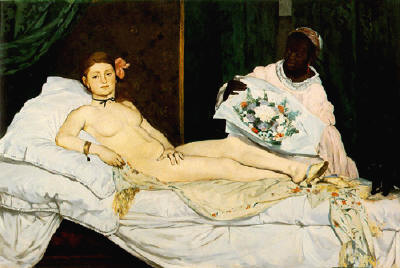
Thus it must be firmly established that from this moment Manet passed as an innovator, years before Impressionism existed or was even thought of. This is an important point: it will help to clear up the twofold origin of the movement which followed. To his realism, to his return to composition in the modern spirit, and to the simplifying of planes and values, Manet owed these attacks, though at that time his colour was still sombre and entirely influenced by Hals, Goya and Courbet. From that time the artist became a chief. As his friends used to meet him at an obscure Batignolles café, the café Guerbois (still existing), public derision baptized these meetings with the name of "L'Ecole des Batignolles." Manet then exhibited the Angels at the Tomb of Christ, a souvenir of the Venetians; Lola de Valence, commented upon by Baudelaire in a quatrain which can be found in the Fleurs du Mal; the Episode d'un combat de taureaux (dissatisfied with this picture, he cut out the dead toreador in the foreground, and burnt the rest). The Acteur tragique (portrait of Rouvière in Hamlet) and the Jésus insulté followed, and then came the Gitanos, L'Enfant à l'Epée, and the portrait of Mme. Manet. This series of works is admirable. It is here where he reveals himself as a splendid colourist, whose design is as vigorous as the technique is masterly. In these works one does not think of looking for anything but the witchery of technical strength; and the abundant wealth of his temperament is simply dazzling. Manet reveals himself as the direct heir of the great Spaniards, more interesting, more spontaneous, and freer than Courbet. The Rouvière is as fine a symphony in grey and black as the noblest portraits by Bronzino, and there is probably no Goya more powerful than the Toréador tué. Manet's altogether classic descent appears here undeniably. There is no question yet of Impressionism, and yet Monet and Renoir are already painting, Monet has exhibited at the Salon des Refusés, but criticism sees and attacks nobody but Manet. This great individuality who overwhelmed the Academy with its weak allegories, was the butt of great insults and the object of great admiration. Banished from the Salons, he collected fifty pictures in a room in the Avenue de l'Alma and invited the public thither. In 1868 appeared the portrait of Emile Zola, in 1860 the Déjeuner, works which are so powerful, that they enforced admiration in spite of all hostility. In the Salon of 1870 was shown the portrait of Eva Gonzalès, the charming pastellist and pupil of Manet, and the impressive Execution of Maximilian at Queretaro. Manet was at the apogee of his talent, when the Franco-German war broke out. At the age of thirty-eight he had put forth a considerable amount of work, tried himself in all styles, severed his individuality from the slavish admiration of the old masters, and attained his own mastery. And now he wanted to expand, and, in joining Monet, Renoir and Degas, interpret in his own way the Impressionist theory.
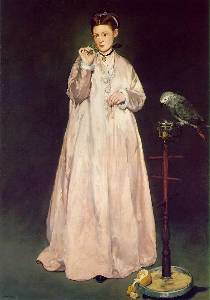
The Fight of the Kearsage and the Alabama, a magnificent sea-piece, bathed in sunlight, announced this transformation in his work, as did also a study, a Garden, painted, I believe, in 1870, but exhibited only after the crisis of the terrible year. At that time the Durand-Ruel Gallery bought a considerable series by the innovator, and was imitated by some select art-lovers. The Musique aux Tuileries and the Bal de l'Opéra had, some years before, pointed towards the evolution of this great artist in the direction of plein-air painting. The Bon Bock, in which the very soul of Hals is revived, and the grave Liseur, sold immediately at Vienne, were the two last pledges given by the artist to his old admirers; these two pictures had moreover a splendid success, and the Bon Bock, popularised by an engraving, was hailed by the very men who had most unjustly attacked the author of the portrait of Mme. Morisot, a French masterpiece. But already Manet was attracted irresistibly towards the study of light, and, faithful to his programme, he prepared to face once again outbursts of anger and further sarcasms; he was resolved once again to offer battle to the Salons. Followed by all the Impressionists he tried to make them understand the necessity of introducing the new ideas into this retrograde Milieu. But they would not. Having already received a rebuff by the attacks directed for some years against their works, they exhibited among themselves in some private galleries: they declined to force the gate of the Salons, and Manet remained alone. In 1875 he submitted, with his Argenteuil, the most perfect epitome of his atmospheric researches. The jury admitted it in spite of loud protests: they were afraid of Manet; they admired his power of transformation, and he revolted the prejudiced, attracting them at the same time by the charm of his force. But in 1876 the portrait of Desboutin and the Linge (an exquisite picture,—one of the best productions of open-air study) were rejected. Manet then recommenced the experience of 1867, and opened his studio to the public. A register at the door was soon covered with signatures protesting against the jury, as well as with hostile jokes, and even anonymous insults! In 1877 the defeated jury admitted the portrait of the famous singer Faure in the part of Hamlet, and rejected Nana, a picture which was found scandalising, but has charming freshness and an intensely modern character. In 1878, 1879 and 1880 they accepted la Serre, the surprising symphony in blue and white which shows Mr George Moore in boating costume, the portrait of Antonin Proust, and the scene at the Père Lathuile restaurant, in which Manet's nervous and luminous realism has so curious a resemblance to the art of the Goncourts. In 1881 the portrait of Rochefort and that of the lion-killer, Pertuiset, procured the artist a medal at the Salon, and Antonin Proust, the friend of Manet's childhood, who had become Minister of Fine Arts, honoured himself in decorating him with the legion of honour. In 1882 appeared a magnificent canvas, the Bar des Folies-Bergère, in which there is some sparkling still-life painting of most attractive beauty. It was accompanied by a lady's portrait, Jeanne. But on April 30, 1883, Manet died, exhausted by his work and struggles, of locomotor ataxy, after having vainly undergone the amputation of a foot to avoid gangrene.
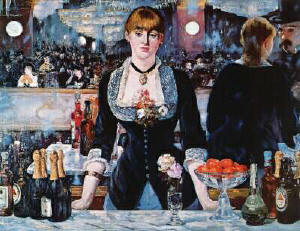
It will be seen that Manet fought through all his life: few artists' lives have been nobler. His has been an example of untiring energy; he employed it as much in working, as in making a stand against prejudices. Rejected, accepted, rejected again, he delivered with enormous courage and faith his attack upon a jury which represented routine. As he fought in front of his easel, he still fought before the public, without ever relaxing, without changing, alone, apart even from those whom he loved, who had been shaped by his example. This great painter, one of those who did most honour to the French soul, had the genius to create by himself an Impressionism of his own which will always remain his own, after having given evidence of gifts of the first order in the tradition handed down by the masters of the real and the good. He cannot be confused either with Monet, or with Pissarro and Renoir. His comprehension of light is a special one, his technique is not in accordance with the system of colour-spots; it observes the theory of complementary colours and of the division of tones without departing from a grand style, from a classic stateliness, from a superb sureness. Manet has not been the inventor of Impressionism which co-existed with his work since 1865, but he has rendered it immense services, by taking upon himself all the outbursts of anger addressed to the innovators, by making a breach in public opinion, through which his friends have passed in behind him. Probably without him all these artists would have remained unknown, or at least without influence, because they all were bold characters in art, but timid or disdainful in life. Degas, Monet and Renoir were fine natures with a horror of polemics, who wished to hold aloof from the Salons, and were resigned from the outset to be misunderstood. They were, so to say, electrified by the magnificent example of Manet's fighting spirit, and Manet was generous enough to take upon himself the reproaches levelled, not only against his work, but against theirs. His twenty years of open war, sustained with an abnegation worthy of all esteem, must be considered as one of the most significant phenomena of the history of the artists of all ages.
This work of Manet, so much discussed and produced under such tormenting conditions, owes its importance beyond all to its power and frankness. Ten years of developing the first manner, tragically limited by the war of 1870; thirteen years of developing the second evolution, parallel with the efforts of the Impressionists. The period from 1860 to 1870 is logically connected with Hals and Goya; from 1870 to 1883 the artist's modernity is complicated by the study of light. His personality appears there even more original, but one may well give the palm to those works of Manet which are painted in his classic and low-toned manner. He had all the pictorial gifts which make the glory of the masters: full, true, broad composition, colouring of irresistible power, blacks and greys which cannot be found elsewhere since Velasquez and Goya, and a profound knowledge of values. He has tried his hand at everything: portraits, landscapes, seascapes, scenes of modern life, still-life and nudes have each in their turn served his ardent desire of creation. His was a much finer comprehension of contemporary life than seems to be admitted by Realism: one has only to compare him with Courbet, to see how far more nervous and intelligent he was, without loss to the qualities of truth and robustness. His pictures will always remain documents of the greatest importance on the society, the manners and customs of the second Empire. He did not possess the gift of psychology. His Christ aux Anges and Jésus insulté are obviously only pieces of painting without idealism. He was, like the great Dutch virtuosos, and like certain Italians, more eye than soul. Yet his Maximilian, the drawings to Poe's Raven, and certain sketches show that he might have realised some curious, psychological works, had he not been so completely absorbed by the immediate reality and by the desire for beautiful paint. A beautiful painter—this is what he was before everything else, this is his fairest fame, and it is almost inconceivable that the juries of the Salons failed to understand him. They waxed indignant over his subjects which offer only a restricted interest, and they did not see the altogether classic quality of this technique without bitumen, without glazing, without tricks; of this vibrating colour; of this rich paint; of this passionate design so suitable for expressing movement and gestures true to life; of this simple composition where the whole picture is based upon two or three values with the straightforwardness one admires in Rubens, Jordaens and Hals.
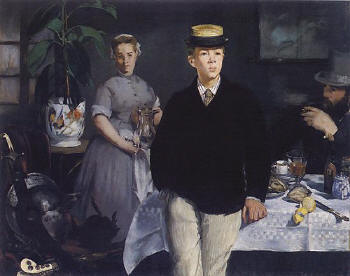
Manet will occupy an important position in the French School. He is the most original painter of the second half of the nineteenth century, the one who has really created a great movement. His work, the fecundity of which is astonishing, is unequal. One has to remember that, besides the incessant strife which he kept up—a strife which would have killed many artists—he had to find strength for two grave crises in himself. He joined one movement, then freed himself of it, then invented another and recommenced to learn painting at a point where anybody else would have continued in his previous manner. "Each time I paint," he said to Mallarmé, "I throw myself into the water to learn swimming." It is not surprising that such a man should have been unequal, and that one can distinguish in his work between experiments, exaggerations due to research, and efforts made to reject the prejudices of which we feel the weight no longer. But it would be unjust to say that Manet has only had the merit of opening up new roads; that has been said to belittle him, after it had first been said that these roads led into absurdity. Works like the Toréador, Rouvière, Mme. Manet, the Déjeuner, the Musique aux Tuileries, the Bon Bock, Argenteuil, Le Linge, En Bateau and the Bar, will always remain admirable masterpieces which will do credit to French painting, of which the spontaneous, living, clear and bold art of Manet is a direct and very representative product.
There remains, then, a great personality who knew how to dominate the rather coarse conceptions of Realism, who influenced by his modernity all contemporary illustration, who re-established a sound and strong tradition in the face of the Academy, and who not only created a new transition, but marked his place on the new road which he had opened. To him Impressionism owes its existence; his tenacity enabled it to take root and to vanquish the opposition of the School; his work has enriched the world by some beautiful examples which demonstrate the union of the two principles of Realism and of that technical Impressionism which was to supply Manet, Renoir, Pissarro and Sisley with an object for their efforts. For the sum total of all that is evoked by his name, Edouard Manet certainly deserves the name of a man of genius—an incomplete genius, though, since the thought with him was not on the level of his technique, since he could never affect the emotions like a Leonardo or a Rembrandt, but genius all the same through the magnificent power of his gifts, the continuity of his style, and the importance of his part which infused blood into a school dying of the anaemia of conventional art. Whoever beholds a work of Manet's, even without knowing the conditions of his life, will feel that there is something great, the lion's claw which Delacroix had recognised as far back as 1861, and to which, it is said, even the great Ingres had paid homage on the jury which examined with disgust the Guitarero.
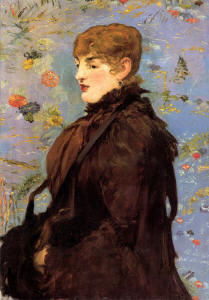
To-day Manet is considered almost as a classic glory; and the progress for which he had given the impulse, has been so rapid, that many are astonished that he should ever have been considered audacious. Sight is transformed, strife is extinguished, and a large, select public, familiar with Monet and Renoir, judge Manet almost as a long defunct initiator. One has to know his admirable life, one has to know well the incredible inertia of the Salons where he appeared, to give him his full due. And when, after the acceptance of Impressionism, the unavoidable reaction will take place, Manet's qualities of solidity, truth and science will appear such, that he will survive many of those to whom he has opened the road and facilitated the success at the expense of his own. It will be seen that Degas and he have, more than the others, and with less apparent éclat, united the gifts which produce durable works in the midst of the fluctuations of fashion and the caprices of taste and views. Manet can, at the Louvre or any other gallery, hold his own in the most crushing surroundings, prove his personal qualities, and worthily represent a period which he loved.
An enormous amount has been written on him, from Zola's bold and intelligent pamphlet in 1865, to the recent work by M. Théodore Duret. Few men have provoked more comments. In an admirable picture, Hommage à Manet, the delicate and perfect painter Fantin-Latour, a friend from the first hour, has grouped around the artist some of his admirers, Monet, Renoir, Duranty, Zola, Bazille, and Braquemond. The picture has to-day a place of honour at the Luxembourg, where Manet is insufficiently represented by Olympia, a study of a woman, and the Balcony. A collection is much to be desired of his lithographs, his etchings and his pastels, in which he has proved his diversified mastery, and also of his portraits of famous contemporaries, Zola, Rochefort, Desboutin, Proust, Mallarmé, Clemenceau, Guys, Faure, Baudelaire, Moore, and others, an admirable series by a visionary who possessed, in a period of unrest and artificiality, the quality of rude sincerity, and the love of truth of a Primitive.
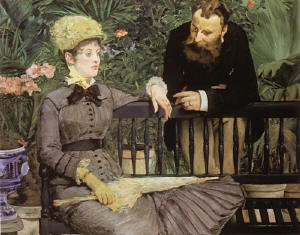
I have said how vain it is to class artistic temperaments under a title imposed upon them generally by circumstances and dates, rather than by their own free will. The study of Degas will furnish additional proof for it. Classed with the Impressionists, this master participates in their ideas in the sphere of composition, rather than in that of colour. He belongs to them through his modernity and comprehension of character. Only when we come to his quite recent landscapes (1896), can we link him to Monet and Renoir as colourist, and he has been more their friend than their colleague.
Degas is known by the select few, and almost ignored by the public. This is due to several reasons. Degas has never wished to exhibit at the Salons, except, I believe, once or twice at the beginning of his career. He has only shown his works at those special exhibitions arranged by the Impressionists in hired apartments (rue le Peletier, rue Laffitte, Boulevard des Capucines), and at some art-dealers. The art of Degas has never had occasion to shock the public by the exuberance of its colour, because he restricted himself to grey and quiet harmonies. Degas is a modest character, fond of silence and solitude, with a horror of the crowd and of controversies, and almost disinclined to show his works. He is a man of intelligence and ready wit, whose sallies are dreaded; he is almost a misanthrope. His pictures have been gradually sold to foreign countries and dispersed in rich galleries without having been seen by the public. His character is, in short, absolutely opposed to that of Manet, who, though he suffered from criticism, thought it his duty to bid it defiance. Degas's influence has, however, been considerable, though secretly so, and the young painters have been slowly inspired by his example.
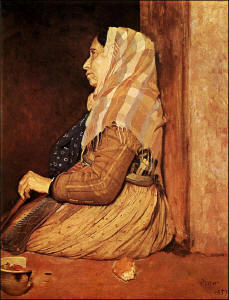
Degas is beyond all a draughtsman of the first order. His spirit is quite classical. He commenced by making admirable copies of the Italian Primitives, notably of Fra Angelico, and the whole first series of his works speaks of that influence: portraits, heads of deep, mat, amber colour, on a ground of black or grey tones, remarkable for a severity of intense style, and for the rare gift of psychological expression. To find the equal of these faces—after having stated their classic descent—one would have to turn to the beautiful things by Ingres, and certainly Degas is, with Ingres, the most learned, the most perfect French draughtsman of the nineteenth century. An affirmation of this nature is made to surprise those who judge Impressionism with preconceived ideas. It is none the less true that, if a series of Degas's first portraits were collected, the comparison would force itself upon one's mind irrefutably. In face of the idealist painting of Romanticism, Ingres represented quite clearly the cult of painting for its own sake. His ideas were mediocre, and went scarcely beyond the poor, conventional ideal of the Academy; but his genius was so great, that it made him paint, together with his tedious allegories, some incomparable portraits and nudes. He thought he was serving official Classicism, which still boasts of his name, but in reality he dominated it; and, whilst he was an imitator of Raphael, he was a powerful Realist. The Impressionists admire him as such, and agree with him in banishing from the art of painting all literary imagination, whether it be the tedious mythology of the School, or the historical anecdote of the Romanticists. Degas and Besnard admire Ingres as colossal draughtsman, and, beyond all, as man who, in spite of the limitations of his mind, preserved the clear vision of the mission of his art at a time when art was used for the expression of literary conceptions. Who would have believed it? Yet it is true, and Manet, too, held the same view of Ingres, little as our present academicians may think it! It happens that to-day Impressionism is more akin to Ingres than to Delacroix, just as the young poets are more akin to Racine than to Hugo. They reject the foreign elements, and search, before anything else, for the strict national tradition. Degas follows Ingres and resembles him. He is also reminiscent of the Primitives and of Holbein. There is, in his first period, the somewhat dry and geometrical perfection, the somewhat heavy colour which only serves to strengthen the correctness of the planes. At the Exposition of 1900, there was a Degas which surprised everybody. It was an Interior of a cotton factory in an American town. This small picture was curiously clear: it would be impossible to paint better and with a more accomplished knowledge of the laws of painting. But it was the work of a soulless, emotionless Realist; it was a coloured photograph of unheard-of truth, the mathematical science of which left the beholder cold. This work, which is very old (it dates back to about 1860), gave no idea of what Degas has grown into. It was the work of an unemotional master of technique; only just the infinitely delicate value of the greys and blacks revealed the future master of harmony. One almost might have wished to find a fault in this aggravating perfection. But Degas was not to remain there, and already, about that time, certain portraits of his are elevated by an expression of ardent melancholy, by warm, ivory-like, grave colouring which attracts one's eye. Before this series one feels the firm will of a very logical, serious, classic spirit who wants to know thoroughly the intimate resources of design, before risking to choose from among them the elements which respond best to his individual nature. If Degas was destined to invent, later on, so personal a style of design that he could be accused of "drawing badly," this first period of his life is before us, to show the slow maturing of his boldness and how carefully he first proved to himself his knowledge, before venturing upon new things. In art the difficulty is, when one has learnt everything, to forget,—that is, to appear to forget, so as to create one's own style, and this apparent forgetting cloaks an amalgamation of science with mind. And Degas is one of those patient and reticent men who spend years in arriving at this; he has much in common with Hokusai, the old man "mad with painting," who at the close of his prodigious life invented arbitrary forms, after having given immortal examples of his interpretation of the real.
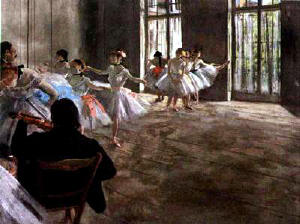
Degas is also clearly related to Corot, not only in the silvery harmonies of his suave landscapes, but also, and particularly, in his admirable faces whose inestimable power and moving sincerity we have hardly commenced to understand. Degas passed slowly from classicism to modernity. He never liked outbursts of colour; he is by no means an Impressionist from this point of view. As a draughtsman of genius he expresses all by the precision of the planes and values; a grey, a black and some notes of colour suffice for him. This might establish a link between him and Whistler, though he is much less mysterious and diffuse. Whenever Degas plays with colour, it is with the same restraint of his boldness; he never goes to excess in abandoning himself to its charm. He is neither lyrical, nor voluptuous; his energy is cold; his wise spirit affirms soberly the true character of a face or an object.
Since a long time this spirit has moved Degas to revel in the observation of contemporary life. His nature has been that of a patient psychologist, a minute analyst, and also of a bitter ironist. The man is very little known. His friends say that he has an easily ruffled delicacy, a sensibility open to poetry, but jealous of showing its emotion. They say that Degas's satirical bitterness is the reverse side of a soul wounded by the spectacle of modern morality. One feels this sentiment in his work, where the sharp notation of truth is painful, where the realism is opposed by colouring of a sober distinction, where nothing, not even the portrait of a drab, could be vulgar. Degas has devoted himself to the profound study of certain classes of women, in the state of mind of a philosopher and physiologist, impartially inclined towards life.
His work can be divided into several great series: the race-courses, the ballet-dancers, and the women bathing count among the most important. The race-courses have inspired Degas with numerous pictures. He shows in them a surprising knowledge of the horse. He is one of the most perfect painters of horses who have ever existed. He has caught the most curious and truest actions with infallible sureness of sight. His racecourse scenes are full of vitality and picturesqueness. Against clear skies, and light backgrounds of lawn, indicated with quiet harmony, Degas assembles original groups of horses which one can see moving, hesitating, intensely alive; and nothing could be fresher, gayer and more deliciously pictorial, than the green, red and yellow notes of the jockey's costumes strewn like flowers over these atmospheric, luminous landscapes, where colours do not clash, but are always gently shimmering, dissolved in uniform clearness. The admirable drawing of horses and men is so precise and seems so simple, that one can only slowly understand the extent of the difficulty overcome, the truth of these attitudes and the nervous delicacy of the execution.
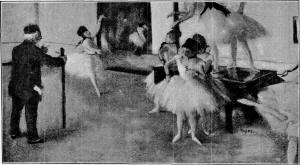
The dancers go much further still in the expression of Degas's temperament. They have been studied at the foyer of the Opera and at the rehearsal, sometimes in groups, sometimes isolated. Some pictures which will always count among the masterpieces of the nineteenth century, represent the whole corps de ballet performing on the stage before a dark and empty house. By the feeble light of some lamps the black coats of the stage managers mix themselves with the gauze skirts. Here the draughtsman joins the great colourist: the petticoats of pink or white tulle, the graceful legs covered with flesh-coloured silk, the arms and the shoulders, and the hair crowned with flowers, offer motives of exquisite colour and of a tone of living flowers. But the psychologist does not lose his rights: not only does he amuse himself with noting the special movements of the dancers, but he also notes the anatomical defects. He shows with cruel frankness, with a strange love of modern character, the strong legs, the thin shoulders, and the provoking and vulgar heads of these frequently ugly girls of common origin. With the irony of an entomologist piercing the coloured insect he shows us the disenchanting reality in the sad shadow of the scenes, of these butterflies who dazzle us on the stage. He unveils the reverse side of a dream without, however, caricaturing; he raises even, under the imperfection of the bodies, the animal grace of the organisms; he has the severe beauty of the true. He gives to his groups of ballet-dancers the charming line of garlands and restores to them a harmony in the ensemble, so as to prove that he does not misjudge the charm conferred upon them by rhythm, however defective they may be individually. At other times he devotes himself to the study of their practice. In bare rooms with curtainless windows, in the cold and sad light of the boxes, he passionately draws the dancers learning their steps, reaching high bars with the tips of their toes, forcing themselves into quaint poses in order to make themselves more supple, manoeuvring to the sound of a fiddle scratched by an old teacher—and he leaves us stupefied at the knowledge, the observation, the talent profusely spent on these little pictures. Furthermore there are humorous scenes: ballet-dancers chatting in the dark with habitués of the Opera, others looking at the house through the small opening of the curtain, others re-tying their shoe-laces, and they all are prodigious drawings of movement anatomically as correct as they are unexpected. Degas's old style of drawing undergoes modification: with the help of slight deformations, accentuations of the modelling and subtle falsifications of the proportions, managed with infinite tact and knowledge, the artist brings forth in relief the important gesture, subordinating to it all the others. He attempts drawing by movement as it is caught by our eyes in life, where they do not state the proportions, but first of all the gesture which strikes them. In these drawings by Degas all the lines follow the impulsion of the thought. What one sees first, is the movement transmitted to the members by the will. The active part of the body is more carefully studied than the rest, which is indicated by bold foreshortenings, placed in the second plane, and apparently only serves to throw into relief the raised arm or leg. This is no longer merely exact, it is true; it is a superior degree of truth.
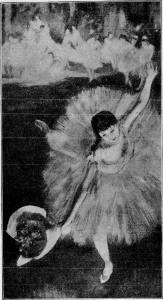
These pictures of dancers are psychologic documents of great value. The physical and moral atmosphere of these surroundings is called forth by a master. Such and such a figure or attitude tells us more about Parisian life than a whole novel, and Degas has been lavish of his intellect and his philosophy of bitter scepticism. But they are also marvellous pictorial studies which, in spite of the special, anecdotal subjects, rise to the level of grand painting through sheer power of draughtsmanship and charm of tone. Degas has the special quality of giving the precise sensation of the third dimension. The atmosphere circulates round his figures; you walk round them; you see them in their real plane, and they present themselves in a thousand unexpected arrangements. Degas is undoubtedly the one man of his age who has most contributed towards infusing new life into the representation of human figures: in this respect his pictures resemble no one else's. The same qualities will be found in his series of women bathing. These interiors, where the actions of the bathers are caught amidst the stuffs, flowered cushions, linen, sponges and tubs, are sharp visions of modernity. Degas observes here, with the tenacious perfection of his talent, the slightest shiver of the flesh refreshed by cold water. His masterly drawing follows the most delicate inflexion of the muscles and suggests the nervous system under the skin. He observes with extraordinary subtlety the awkwardness of the nude being at a time when nudity is no longer accustomed to show itself, and this true nudity is in strong contrast to that of the academicians. One might say of Degas that he has the disease of truth, if the necessity of truth were not health itself! These bodies are still marked with the impressions of the garments; the movements remain those of a clothed being which is only nude as an exception. The painter notices beauty, but he looks for it particularly in the profound characterisation of the types which he studies, and his pastels have the massiveness and the sombre style of bronze. He has also painted café-scenes, prostitutes and supers, with a mocking and sad energy; he has even amused himself with painting washerwomen, to translate the movements of the women of the people. And his colour with its pearly whites, subdued blues and delicate greys, always elevates everything he does, and confers upon him a distinctive style.
Finally, about 1896, Degas has revealed himself as a dreamy landscapist. His recent landscapes are symphonies in colours of strange harmony and hallucinations of rare tones, resembling music rather than painting. It is perhaps in these pictures that he has revealed certain dreams hitherto jealously hidden.
And now I must speak of his technique. It is very singular and varied, and one of the most complicated in existence. In his first works, which are apparently as simple as Corot's, he does not employ the process of colour-spots. But many of the works in his second manner are a combination of drawing, painting and pastel. He has invented a kind of engraving mixed with wash-drawing, pastel crayon crushed with brushes of special pattern. Here one can find again his meticulous spirit. He has many of the qualities of the scientist; he is as much chemist as painter. It has been said of him, that he was a great artist of the decadence. This is materially inexact, since his qualities of draughtsmanship are those of a superb Classicist, and his colouring of very pure taste. But the spirit of his work, his love of exact detail, his exaggerated psychological refinement, are certainly the signs of an extremely alert intellect who regards life prosaically and with a lassitude and disenchantment which are only consoled by the passion for truth. Certain water-colours of his heightened by pastel, and certain landscapes, are somewhat disconcerting through the preciousness of his method; others are surprisingly spontaneous. All his work has an undercurrent of thought. In short, this Realist is almost a mystic. He has observed a limited section of humanity, but what he has seen has not been seen so profoundly by anybody else.
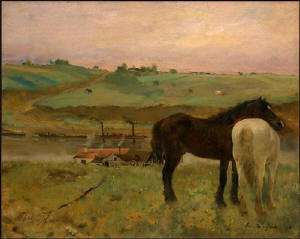
Degas has exercised an occult, but very serious, influence. He has lived alone, without pupils and almost without friends; the only pupils one might speak of are the caricaturist Forain, who has painted many small pictures inspired by him, and the excellent American lady-artist Miss Mary Cassatt. But all modern draughtsmen have been taught a lesson by his painting: Renouard, Toulouse-Lautrec and Steinlen have been impressed by it, and the young generation considers Degas as a master. And that is also the unexpressed idea of the academicians, and especially of those who have sufficient talent to be able to appreciate all the science and power of such an art. The writer of this book happened one day to mention Degas's name before a member of the Institute. "What!" exclaimed he, "you know him? Why didn't you speak to me about him?" And when he received the reply, that I did not consider Degas to be an agreeable topic for him, the illustrious official answered vivaciously, "But do you think I am a fool, and that I do not know that Degas is one of the greatest draughtsmen who have ever lived?"—"Why, then, my dear sir, has he never been received at the Salons, and not even been decorated at the age of sixty-five?"—"Ah," replied the Academician a little angrily, "that is another matter!"
Degas despises glory. It is believed that he has by him a number of canvases which will have to be burnt after his death in accordance with his will. He is a man who has loved his art like a mistress, with jealous passion, and has sacrificed to it all that other artists—enthusiasts even—are accustomed to reserve for their personal interest. Degas, the incomparable pastellist, the faultless draughtsman, the bitter, satirical, pessimistic genius, is an isolated phenomenon in his period, a grand creator, unattached to his time. The painters and the select few among art-lovers know what considerable force there is in him. Though almost latent as yet, it will reveal itself brilliantly, when an opportunity arises for bringing together the vast quantity of his work. As is the case with Manet, though in a different sense, his powerful classic qualities will become most prominent in this ordeal, and this classicism has never abandoned him in his audacities. To Degas is due a new method of observation in drawing. He will have been the first to study the relation between the moving lines of a living being and the immovable lines of the scene which serves as its setting; the first, also, to define drawing, not as a graphic science, but as the valuation of the third dimension, and thus to apply to painting the principles hitherto reserved for sculpture. Finally, he will be counted among the great analysts. His vision, tenacious, intense, and sombre, stimulates thought: across what appears to be the most immediate and even the most vulgar reality it reaches a grand, artistic style; it states profoundly the facts of life, it condenses a little the human soul: and this will suffice to secure for Degas an important place in his epoch, a little apart from Impressionism. Without noise, and through the sheer charm of his originality, he has contributed his share towards undermining the false doctrines of academic art before the painters, as Manet has undermined them before the public.
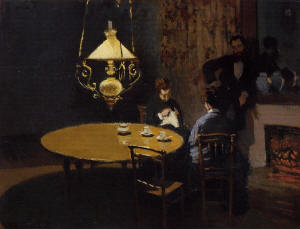
With Claude Monet we enter upon Impressionism in its most significant technical expression, and touch upon the principal points referred to in the second chapter of this book.
Claude Monet, the artistic descendant of Claude Lorrain, Turner, and Monticelli, has had the merit and the originality of opening a new road to landscape painting by deducing scientific statements from the study of the laws of light. His work is a magnificent verification of the optical discoveries made by Helmholtz and Chevreul. It is born spontaneously from the artist's vision, and happens to be a rigorous demonstration of principles which the painter has probably never cared to know. Through the power of his faculties the artist has happened to join hands with the scientist. His work supplies not only the very basis of the Impressionist movement proper, but of all that has followed it and will follow it in the study of the so-called chromatic laws. It will serve to give, so to say, a mathematic necessity to the happy finds met by the artists hitherto, and it will also serve to endow decorative art and mural painting with a process, the applications of which are manyfold and splendid.
I have already summed up the ideas which follow from Claude Monet's painting more clearly even than from Manet's. Suppression of local colour, study of reflections by means of complementary colours and division of tones by the process of touches of pure, juxtaposed colours—these are the essential principles of chromatism (for this word should be used instead of the very vague term "Impressionism"). Claude Monet has applied them systematically, especially in landscape painting.
There are a few portraits of his, which show that he might have made an excellent figure painter, if landscape had not absorbed him entirely. One of these portraits, a large full-length of a lady with a fur-lined jacket and a satin dress with green and black stripes, would in itself be sufficient to save from oblivion the man who has painted it. But the study of light upon the figure has been the special preoccupation of Manet, Renoir, and Pissarro, and, after the Impressionists, of the great lyricist, Albert Besnard, who has concentrated the Impressionist qualities by placing them at the service of a very personal conception of symbolistic art. Monet commenced with trying to find his way by painting figures, then landscapes and principally sea pictures and boats in harbours, with a somewhat sombre robustness and very broad and solid draughtsmanship. His first luminous studies date back to about 1885. Obedient to the same ideas as Degas he had to avoid the Salons and only show his pictures gradually in private galleries. For years he remained unknown. It is only giving M. Durand-Ruel his due, to state that he was one of the first to anticipate the Impressionist school and to buy the first works of these painters, who were treated as madmen and charlatans. He has become great with them, and has made his fortune and theirs through having had confidence in them, and no fortune has been better deserved. Thirty years ago nobody would have bought pictures by Degas or Monet, which are sold to-day for a thousand pounds. This detail is only mentioned to show the evolution of Impressionism as regards public opinion.
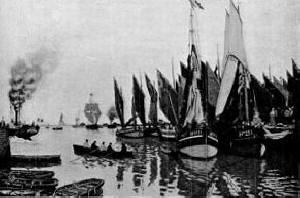
So much has Monet been attracted by the analysis of the laws of light that he has made light the real subject of all his pictures, and to show clearly his intention he has treated one and the same site in a series of pictures painted from nature at all hours of the day. This is the principle whose results are the great divisions of his work which might be called "Investigation of the variations of sunlight." The most famous of these series are the Hay-ricks, the Poplars, the Cliffs of Etretat, the Golfe Juan, the Coins de Rivière, the Cathedrals, the Water-lilies, and finally the Thames series which Monet is at present engaged upon. They are like great poems, and the splendour of the chosen theme, the orchestration of the shivers of brightness, the symphonic parti-pris of the colours, make their realism, the minute contemplation of reality, approach idealism and lyric dreaming.
Monet paints these series from nature. He is said to take with him in a carriage at sunrise some twenty canvases which he changes from hour to hour, taking them up again the next day. He notes, for example, from nine to ten o'clock the most subtle effects of sunlight upon a hay-rick; at ten o'clock he passes on to another canvas and recommences the study until eleven o'clock. Thus he follows step by step the modifications of the atmosphere until nightfall, and finishes simultaneously the works of the whole series. He has painted a hay-stack in a field twenty times over, and the twenty hay-stacks are all different. He exhibits them together, and one can follow, led by the magic of his brush, the history of light playing upon one and the same object. It is a dazzling display of luminous atoms, a kind of pantheistic evocation. Light is certainly the essential personage who devours the outlines of the objects, and is thrown like a translucent veil between our eyes and matter. One can see the vibrations of the waves of the solar spectrum, drawn by the arabesque of the spots of the seven prismatic hues juxtaposed with infinite subtlety; and this vibration is that of heat, of atmospheric vitality. The silhouettes melt into the sky; the shadows are lights where certain tones, the blue, the purple, the green and the orange, predominate, and it is the proportional quantity of the spots that differentiates in our eyes the shadows from what we call the lights, just as it actually happens in optic science. There are some midday scenes by Claude Monet, where every material silhouette—tree, hay-rick, or rock—is annihilated, volatilised in the fiery vibration of the dust of sunlight, and before which the beholder gets really blinded, just as he would in actual sunlight. Sometimes even there are no more shadows at all, nothing that could serve to indicate the values and to create contrasts of colours. Everything is light, and the painter seems easily to overcome those terrible difficulties, lights upon lights, thanks to a gift of marvellous subtlety of sight.
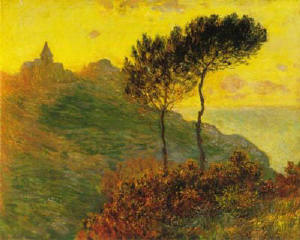
Generally he finds a very simple motif sufficient; a hay-rick, some slender trunks rising skywards, or a cluster of shrubs. But he also proves himself as powerful draughtsman when he attacks themes of greater complexity. Nobody knows as he does how to place a rock amidst tumultuous waves, how to make one understand the enormous construction of a cliff which fills the whole canvas, how to give the sensation of a cluster of pines bent by the wind, how to throw a bridge across a river, or how to express the massiveness of the soil under a summer sun. All this is constructed with breadth, truth and force under the delicious or fiery symphony of the luminous atoms. The most unexpected tones play in the foliage. On close inspection we are astonished to find it striped with orange, red, blue and yellow touches, but seen at a certain distance the freshness of the green foliage appears to be represented with infallible truth. The eye recomposes what the brush has dissociated, and one finds oneself perplexed at all the science, all the secret order which has presided over this accumulation of spots which seem projected in a furious shower. It is a veritable orchestral piece, where every colour is an instrument with a distinct part, and where the hours with their different tints represent the successive themes. Monet is the equal of the greatest landscape painters as regards the comprehension of the true character of every soil he has studied, which is the supreme quality of his art. Though absorbed beyond all by study of the sunlight, he has thought it useless to go to Morocco or Algeria. He has found Brittany, Holland, the Ile de France, the Cote d'Azur and England sufficient sources of inspiration for his symphonies, which cover from end to end the scale of perceptible colours. He has expressed, for instance, the mild and vaporous softness of the Mediterranean, the luxuriant vegetation of the gardens of Cannes and Antibes, with a truthfulness and knowledge of the psychology of land and water which can only be properly appreciated by those who live in this enchanted region. This has not prevented him from understanding better than anybody the wildness, the grand austereness of the rocks of Belle-Isle en mer, to express it in pictures in which one really feels the wind, the spray, and the roaring of the heavy waters breaking against the impassibility of the granite rocks. His recent series of Water-lilies expressed all the melancholic and fresh charm of quiet basins, of sweet bits of water blocked by rushes and calyxes. He has painted underwoods in the autumn, where the most subtle shades of bronze and gold are at play, chrysanthemums, pheasants, roofs at twilight, dazzling sunflowers, gardens, tulip-fields in Holland, bouquets, effects of snow and hoar frost of exquisite softness, and sailing boats passing in the sun. He has painted some views of the banks of the Seine which are quite wonderful in their power of conjuring up these scenes, and over all this has roved his splendid vision of a great, amorous and radiant colourist. The Cathedrals are even more of a tour de force of his talent. They consist of seventeen studies of Rouen Cathedral, the towers of which fill the whole of the picture, leaving barely a little space, a little corner of the square, at the foot of the enormous stone-shafts which mount to the very top of the picture. Here he has no proper means to express the play of the reflections, no changeful waters or foliage: the grey stone, worn by time and blackened by centuries, is for seventeen times the monochrome, the thankless theme upon which the painter is about to exercise his vision. But Monet finds means of making the most dazzling atmospheric harmonies sparkle upon this stone. Pale and rosy at sunrise, purple at midday, glowing in the evening under the rays of the setting sun, standing out from the crimson and gold, scarcely visible in the mist, the colossal edifice impresses itself upon the eye, reconstructed with its thousand details of architectural chiselling, drawn without minuteness but with superb decision, and these pictures approach the composite, bold and rich tone of Oriental carpets.
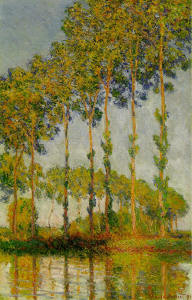
Monet excels also in suggesting the drawing of light, if I may venture to use this expression. He makes us understand the movement of the vibrations of heat, the movement of the luminous waves; he also understands how to paint the sensation of strong wind. "Before one of Manet's pictures," said Mme. Morisot, "I always know which way to incline my umbrella." Monet is also an incomparable painter of water. Pond, river, or sea—he knows how to differentiate their colouring, their consistency, and their currents, and he transfixes a moment of their fleeting life. He is intuitive to an exceptional degree in the intimate composition of matter, water, earth, stone or air, and this intuition serves him in place of intellectuality in his art. He is a painter par excellence, a man born for painting, and this power of penetrating the secrets of matter and of light helps him to attain a kind of grand, unconsciously lyrical poetry. He transposes the immediate truth of our vision and elevates it to decorative grandeur. If Manet is the realist-romanticist of Impressionism, if Degas is its psychologist, Claude Monet is its lyrical pantheist.
His work is immense. He produces with astonishing rapidity, and he has yet another characteristic of the great painters: that of having put his hand to every kind of subject. His recent studies of the Thames are, at the decline of his energetic maturity, as beautiful and as spontaneous as the Hay-ricks of seventeen years back. They are thrillingly truthful visions of fairy mists, where showers of silver and gold sparkle through rosy vapours; and at the same time Monet combines in this series the dream-landscapes of Turner with Monticelli's accumulation of precious stones. Thus interpreted by this intense faculty of synthesis, nature, simplified in detail and contemplated in its grand lines, becomes truly a living dream.
Since the Hay-ricks one can say that the work of Claude Monet is glorious. It has been made sacred to the admiring love of the connoisseurs on the day when Monet joined Rodin in an exhibition which is famous in the annals of modern art. Yet no official distinction has intervened to recognise one of the greatest painters of the nineteenth century. The influence of Monet has been enormous all over Europe and America. The process of colour spots2 (let us adhere to this rudimentary name which has become current) has been adopted by a whole crowd of painters. I shall have to say a few words about it at the end of this book. But it is befitting to terminate this all too short study by explaining that the most lyrical of the Impressionists has also been the theorist par excellence. His work connects easel painting with mural painting. No Minister of Fine Arts has been found, who would surmount the systematic opposition of the official painters, and give Manet a commission for grand mural compositions, for which his method is admirably suited. It has taken long years before such works were entrusted to Besnard, who, with Puvis de Chavannes, has given Paris her most beautiful modern decorations, but Besnard's work is the direct outcome of Claude Monet's harmonies. The principle of the division of tones and of the study of complementary colours has been full of revelations, and one of the most fruitful theories. It has probably been the principle which will designate most clearly the originality of the painting of the future. To have invented it, is enough to secure permanent glory for a man. And without wishing to put again the question of the antagonism of realism and idealism, one may well say that a painter who invents a method and shows such power, is highly intellectual and gifted with a pictorial intelligence. Whatever the subjects he treats, he creates an aesthetic emotion equivalent, if not similar, to those engendered by the most complex symbolism. In his ardent love of nature Monet has found his greatness; he suggests the secrets by stating the evident facts. That is the law common to all the arts.
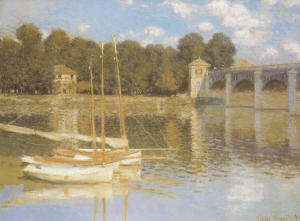
The work of Auguste Renoir extends without interruption over a period of forty years. It appears to sum up the ideas and methods of Impressionist art so completely that, should it alone be saved from a general destruction, it would suffice to bear witness to this entire art movement. It has unfolded itself from 1865 to our days with a happy magnificence, and it allows us to distinguish several periods, in the technique at least, since the variety of its subjects is infinite. Like Manet, and like all truly great and powerful painters, M. Renoir has treated almost everything, nudes, portraits, subject pictures, seascapes and still-life, all with equal beauty.
His first manner shows him to be a very direct descendant of Boucher. His female nudes are altogether in eighteenth century taste and he uses the same technique as Boucher: fat and sleek paint of soft brilliancy, laid on with the palette knife, with precise strokes round the principal values; pink and ivory tints relieved by strong blues similar to those of enamels; the light distributed everywhere and almost excluding the opposition of the shadows; and, finally, vivacious attitudes and an effort towards decorative convention. Nevertheless, his Bathers, of which he has painted a large series, are in many ways thoroughly modern and personal. Renoir's nude is neither that of Monet, nor of Degas, whose main concern was truth, the last-named even trying to define in the undressed being such psychologic observations as are generally looked for in the features of the clothed being. Nor is Renoir's nude that of the academicians, that poetised nude arranged according to a pseudo-Greek ideal, which has nothing in common with contemporary women. What Renoir sees in the nude is less the line, than the brilliancy of the epidermis, the luminous, nacreous substance of the flesh: it is the "ideal clay"; and in this he shows the vision of a poet; he transfigures reality, but in a very different sense from that of the School. Renoir's woman comes from a primitive dream-land; she is an artless, wild creature, blooming in perfumed scrub. He sets her in backgrounds of foliage or of blue, foam-fringed torrents. She is a luxuriant, firm, healthy and naïve woman with a powerful body, a small head, her eyes wide open, thoughtless, brilliant and ignorant, her lips blood-red and her nostrils dilated; she is a gentle being, like the women of Tahiti, born in a tropical clime where vice is as unknown as shame, and where entire ingenuousness is a guarantee against all indecency. One cannot but be astonished at this mixture of "Japanism," savagism and eighteenth century taste, which constitutes inimitably the nude of Renoir.
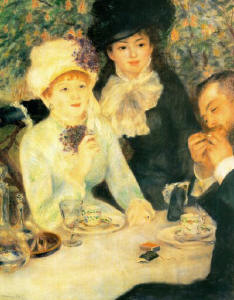
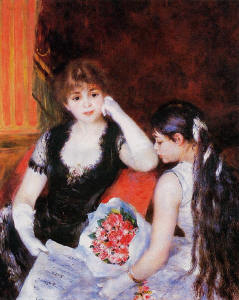
M. Renoir's second manner is more directly related to the Impressionist methods: it is that of his landscapes, his flowers and his portraits. Here one can feel his relationship with Manet and with Claude Monet. These pictures are hatchings of colours accumulated to render less the objects than their transparency across the atmosphere. The portraits are frankly presented and broadly executed. The artist occupies himself in the first place with getting correct values and an exact suggestion of depth. He understands the illogicality of a false perfection which is as interested in a trinket as in an eye, and he knows how to proportion the interest of the picture which should guide the beholder's look to the essential point, though every part should be correctly executed. He knows how to interpret nature in a certain sense; how to stop in time; how to suggest by leaving a part apparently unfinished; how to indicate, behind a figure, the sea or some landscape with just a few broad touches which suffice to suggest it without usurping the principal part. It is now, that Renoir paints his greatest works, the Déjeûner des Canotiers, the Bal au Moulin de la Galette, the Box, the Terrace, the First Step, the Sleeping Woman with a Cat, and his most beautiful landscapes; but his nature is too capricious to be satisfied with a single technique. There are some landscapes that are reminiscent of Corot or of Anton Mauve; the Woman with the broken neck is related to Manet; the portrait of Sisley invents pointillism fifteen years before the pointillists; La Pensée, this masterpiece, evokes Hoppner. But in everything reappears the invincible French instinct: the Jeune Fille au panier is a Greuze painted by an Impressionist; the delightful Jeune Fille à la promenade is connected with Fragonard; the Box, a perfect marvel of elegance and knowledge, condenses the whole worldliness of 1875. The portrait of Jeanne Samary is an evocation of the most beautiful portraits of the eighteenth century, a poem of white satin and golden hair.
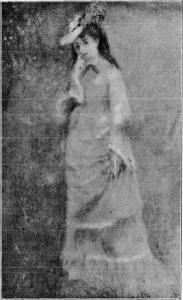
Renoir's realism bears in spite of all, the imprint of the lyric spirit and of sweetness. It has neither the nervous veracity of Manet, nor the bitterness of Degas, who both love their epoch and find it interesting without idealising it and who have the vision of psychologist novelists. Before everything else he is a painter. What he sees in the Bal au Moulin de la Galette, are not the stigmata of vice and impudence, the ridiculous and the sad sides of the doubtful types of this low resort. He sees the gaiety of Sundays, the flashes of the sun, the oddity of a crowd carried away by the rhythm of the valses, the laughter, the clinking of glasses, the vibrating and hot atmosphere; and he applies to this spectacle of joyous vulgarity his gifts as a sumptuous colourist, the arabesque of the lines, the gracefulness of his bathers, and the happy eurythmy of his soul. The straw hats are changed into gold, the blue jackets are sapphires, and out of a still exact realism is born a poem of light. The Déjeûner des Canotiers is a subject which has been painted a hundred times, either for the purpose of studying popular types, or of painting white table-cloths amidst sunny foliage. Yet Renoir is the only painter who has raised this small subject to the proportions and the style of a large canvas, through the pictorial charm and the masterly richness of the arrangement. The Box, conceived in a low harmony, in a golden twilight, is a work worthy of Reynolds. The pale and attentive face of the lady makes one think of the great English master's best works; the necklace, the flesh, the flounce of lace and the hands are marvels of skill and of taste, which the greatest modern virtuosos, Sargent and Besnard, have not surpassed, and, as far as the man in the background is concerned, his white waistcoat, his dress-coat, his gloved hand would suffice to secure the fame of a painter. The Sleeping Woman, the First Step, the Terrace, and the decorative Dance panels reveal Renoir as an intimiste and as an admirable painter of children. His strange colouring and his gifts of grasping nature and of ingenuity—strangers to all decadent complexity—have allowed him to rank among the best of those who have expressed childhood in its true aspect, without overloading it with over-precocious thoughts. Finally, Renoir is a painter of flowers of dazzling variety and exquisite splendour. They supply him with inexhaustible pretexts for suave and subtle harmonies.
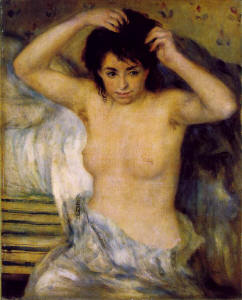
His third manner has surprised and deceived certain admirers of his. It seems to mix his two first techniques, combining the painting with the palette knife and the painting in touches of divided tones. He searches for certain accords and contrasts almost analogous to the musical dissonances. He realises incredible "false impressions." He seems to take as themes oriental carpets: he abandons realism and style and conceives symphonies. He pleases himself in assembling those tones which one is generally afraid of using: Turkish pink, lemon, crushed strawberry and viridian. Sometimes he amuses himself with amassing faded colours which would be disheartening with others, but out of which he can extract a harmony. Sometimes he plays with the crudest colours. One feels disturbed, charmed, disconcerted, as one would before an Indian shawl, a barbaric piece of pottery or a Persian miniature, and one refrains from forcing into the limits of a definition this exceptional virtuoso whose passionate love of colour overcomes every difficulty. It is in this most recent part of his evolution, that Renoir appears the most capricious and the most poetical of all the painters of his generation. The flowers find themselves treated in various techniques according to their own character: the gladioles and roses in pasty paint, the poor flowers of the field are defined by a cross-hatching of little touches. Influenced by the purple shadow of the large flower-decked hats, the heads of young girls are painted on coarse canvas, sketched in broad strokes, with the hair in one colour only. Some little study appears like wool, some other has the air of agate, or is marbled and veined according to his inexplicable whim. We have here an incessant confusion of methods, a complete emancipation of the virtuoso who listens only to his fancy. Now and then the harmonies are false and the drawing incorrect, but these weaknesses do at least no harm to the values, the character and the general movement of the work, which are rather accentuated by them.
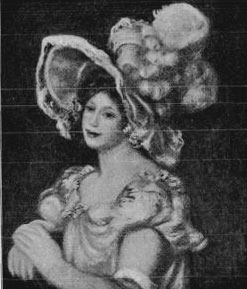
Surely, it would be false to exclude ideologist painting which has produced wonders, and not less iniquitous to reproach Impressionism with not having taken any interest in it! One has to avoid the kind of criticism which consists in reproaching one movement with not having had the qualities of the others whilst maintaining its own, and we have abandoned the idea of Beauty divided into a certain number of clauses and programmes, towards the sum total of which the efforts of the eclectic candidates are directed. M. Renoir is probably the most representative figure of a movement where he seems to have united all the qualities of his friends. To criticise him means to criticise Impressionism itself. Having spent half of its strength in proving to its adversaries that they were wrong, and the other half in inventing technical methods, it is not surprising to find that Impressionism has been wanting in intellectual depth and has left to its successors the care of realising works of great thought. But it has brought us a sunny smile, a breath of pure air. It is so fascinating, that one cannot but love its very mistakes which make it more human and more accessible. Renoir is the most lyrical, the most musical, the most subtle of the masters of this art. Some of his landscapes are as beautiful as those of Claude Monet. His nudes are as masterly in painting as Manet's, and more supple. Not having attained the scientific drawing which one finds in Degas's, they have a grace and a brilliancy which Degas's nudes have never known. If his rare portraits of men are inferior to those of his rivals, his women's portraits have a frequently superior distinction. His great modern compositions are equal to the most beautiful works by Manet and Degas. His inequalities are also more striking than theirs. Being a fantastic, nervous improvisator he is more exposed to radical mistakes. But he is a profoundly sincere and conscientious artist.
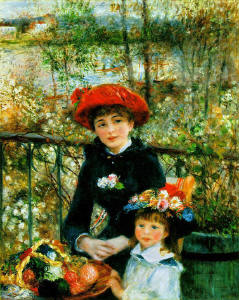
The race speaks in him. It is inexplicable that he should not have met with startling success, since he is voluptuous, bright, happy and learned without heaviness. One has to attribute his relative isolation to the violence of the controversies, and particularly to the dignity of a poet gently disdainful of public opinion and paying attention solely to painting, his great and only love. Manet has been a fighter whose works have created scandal. Renoir has neither shown, nor hidden himself: he has painted according to his dream, spreading his works, without mixing up his name or his personality with the tumult that raged around his friends. And now, for that very reason, his work appears fresher and younger, more primitive and candid, more intoxicated with flowers, flesh and sunlight.
.
Manet, Degas, Monet and Renoir will present themselves as a glorious quartet of masters, in the history of painting. We must now speak of some personalities who have grown up by their side and who, without being great, offer nevertheless a rich and beautiful series of works.
Of these personalities the most considerable is certainly that of M. Camille Pissarro. He painted according to some wise and somewhat timid formulas, when Manet's example won him over to Impressionism to which he has remained faithful. M. Pissarro has been enormously productive. His work is composed of landscapes, rustic scenes, and studies of streets and markets. His first landscapes are in the manner of Corot, but bathed in blond colour: vast cornfields, sunny woods, skies with big, flocking clouds, effects of soft light—these are the motifs of some charming canvases which have a solid, classic quality. Later the artist adopted the method of the dissociation of tones, from which he obtained some happy effects. His harvest and market scenes are luminous and alive. The figures in these recall those of Millet. They bear witness to high qualities of sincere observation, and are the work of a man profoundly enamoured of rustic life. M. Pissarro excels in grouping the figures, in correctly catching their attitudes and in rendering the medley of a crowd in the sun. Certain fans in particular will always remain delightful caprices of fresh colour, but it would be vain to look in this attractive, animated and clear painting for the psychologic gifts, the profound feeling for grand silhouettes, and the intuition of the worn and gloomy soul of the men of the soil, which have made Millet's noble glory. At the time when, about 1885, the neo-Impressionists whom we shall study later on invented the Pointillist method, M. Pissarro tried it and applied it judiciously, with the patient, serious and slightly anxious talent, by which he is distinguished. Recently, in a series of pictures representing views of Paris (the boulevards and the Avenue de l'Opéra) M. Pissarro has shewn rare vision and skill and has perhaps signed his most beautiful and personal paintings. The perspective, the lighting, the tones of the houses and of the crowds, the reflections of rain or sunshine are intensely true; they make one feel the atmosphere, the charm and the soul of Paris. One can say of Pissarro that he lacks none of the gifts of his profession. He is a learned, fruitful and upright artist. But he has lacked originality; he always recalls those whom he admires and whose ideas he applies boldly and tastefully. It is probable that his conscientious nature has contributed not little towards keeping him in the second rank. Incapable, certainly, of voluntarily imitating, this excellent and diligent painter has not had the sparks of genius of his friends, but all that can be given to a man through conscientious study, striving after truth and love of art, has been acquired by M. Pissarro. The rest depended on destiny only. There is no character more worthy of respect and no effort more meritorious than his, and there can be no better proof of his disinterestedness and his modesty, than the fact that, although he has thirty years of work behind him, an honoured name and white hair, M. Pissarro did not hesitate to adopt, quite frankly, the technique of the young Pointillist painters, his juniors, because it appeared to him better than his own. He is, if not a great painter, at least one of the most interesting rustic landscape painters of our epoch. His visions of the country are quite his own, and are a harmonious mixture of Classicism and Impressionism which will secure one of the most honourable places to his work.
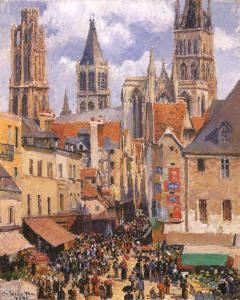
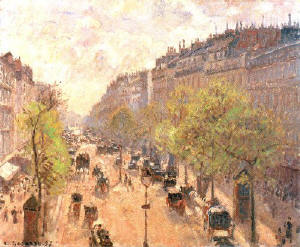
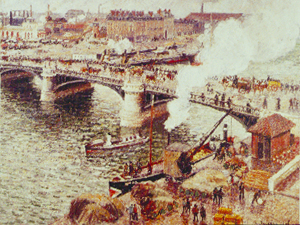
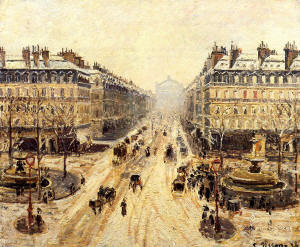
There has, perhaps, been more original individuality in the landscape painter Alfred Sisley. He possessed in the highest degree the feeling for light, and if he did not have the power, the masterly passion of Claude Monet, he will at least deserve to be frequently placed by his side as regards the expression of certain combinations of light. He did not have the decorative feeling which makes Monet's landscapes so imposing; one does not see in his work that surprising lyrical interpretation which knows how to express the drama of the raging waves, the heavy slumber of enormous masses of rock, the intense torpor of the sun on the sea. But in all that concerns the mild aspects of the Ile de France, the sweet and fresh landscapes, Sisley is not unworthy of being compared with Monet. He equals him in numerous pictures; he has a similar delicacy of perception, a similar fervour of execution. He is the painter of great, blue rivers curving towards the horizon; of blossoming orchards; of bright hills with red-roofed hamlets scattered about; he is, beyond all, the painter of French skies which he presents with admirable vivacity and facility. He has the feeling for the transparency of atmosphere, and if his technique allies him directly with Impressionism, one can well feel, that he painted spontaneously and that this technique happened to be adapted to his nature, without his having attempted to appropriate it for the sake of novelty. Sisley has painted a notable series of pictures in the quaint village of Moret on the outskirts of the Forest of Fontainebleau, where he died at a ripe age, and these canvases will figure among the most charming landscapes of our epoch. Sisley was a veteran of Impressionism. At the Exhibition of 1900, in the two rooms reserved for the works of this school, there were to be seen a dozen of Sisley's canvases. By the side of the finest Renoirs, Monets and Manets they kept their charm and their brilliancy with a singular flavour, and this was for many critics a revelation as to the real place of this artist, whom they had hitherto considered as a pretty colourist of only relative importance.
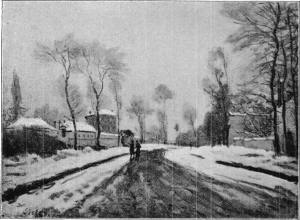
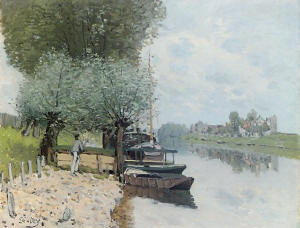
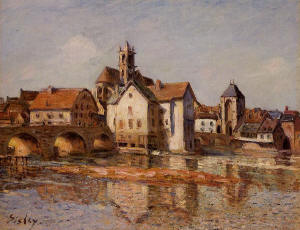
Paul Cézanne, unknown to the public, is appreciated by a small group of art lovers. He is an artist who lives in Provence, away from the world; he is supposed to have served as model for the Impressionist painter Claude Lantier, described by Zola in his celebrated novel "L'Oeuvre." Cézanne has painted landscapes, rustic scenes and still-life pictures. His figures are clumsy and brutal and inharmonious in colour, but his landscapes have the merit of a robust simplicity of vision. These pictures are almost primitive, and they are loved by the young Impressionists because of their exclusion of all "cleverness." A charm of rude simplicity and sincerity can be found in these works in which Cézanne employs only just the means which are indispensable for his end. His still-life pictures are particularly interesting owing to the spotless brilliancy of their colours, the straightforwardness of the tones, and the originality of certain shades analogous to those of old faience. Cézanne is a conscientious painter without skill, intensely absorbed in rendering what he sees, and his strong and tenacious attention has sometimes succeeded in finding beauty. He reminds more of an ancient Gothic craftsman, than of a modern artist, and he is full of repose as a contrast to the dazzling virtuosity of so many painters.
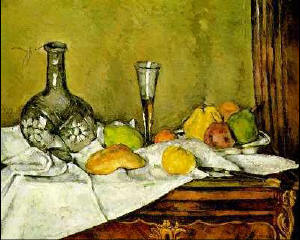
Berthe Morisot will remain the most fascinating figure of Impressionism,—the one who has stated most precisely the femineity of this luminous and iridescent art. Having married Eugène Manet, the brother of the great painter, she exhibited at various private galleries, where the works of the first Impressionists were to be seen, and became as famous for her talent as for her beauty. When Manet died, she took charge of his memory and of his work, and she helped with all her energetic intelligence to procure them their just and final estimation. Mme. Eugène Manet has certainly been one of the most beautiful types of French women of the end of the nineteenth century. When she died prematurely at the age of fifty (in 1895), she left a considerable amount of work: gardens, young girls, water-colours of refined taste, of surprising energy, and of a colouring as distinguished, as it is unexpected. As great grand-daughter of Fragonard, Berthe Morisot (since we ought to leave her the name with which her respect for Manet's great name made her always sign her works) seemed to have inherited from her famous ancestor his French gracefulness, his spirited elegance, and all his other great qualities. She has also felt the influence of Corot, of Manet and of Renoir. All her work is bathed in brightness, in azure, in sunlight; it is a woman's work, but it has a strength, a freedom of touch and an originality, which one would hardly have expected. Her water-colours, particularly, belong to a superior art: some notes of colour suffice to indicate sky, sea, or a forest background, and everything shows a sure and masterly fancy, for which our time can offer no analogy. A series of Berthe Morisot's works looks like a veritable bouquet whose brilliancy is due less to the colour-schemes which are comparatively soft, grey and blue, than to the absolute correctness of the values. A hundred canvases, and perhaps three hundred water-colours attest this talent of the first rank. Normandy coast scenes with pearly skies and turquoise horizons, sparkling Nice gardens, fruit-laden orchards, girls in white dresses with big flower-decked hats, young women in ball-dress, and flowers are the favourite themes of this artist who was the friend of Renoir, of Degas and of Mallarmé.
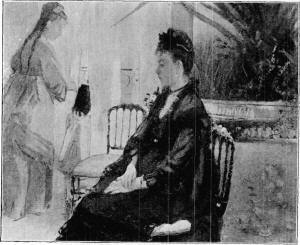
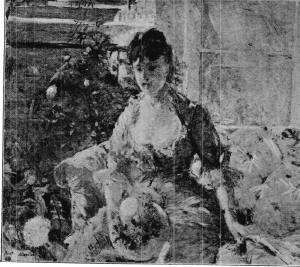
Miss Mary Cassatt will deserve a place by her side. American by birth, she became French through her assiduous participation in the exhibitions of the Impressionists. She is one of the very few painters whom Degas has advised, with Forain and M. Ernest Rouart. (This latter, a painter himself, a son of the painter and wealthy collector Henri Rouart, has married Mme. Manet's daughter who is also an artist.) Miss Cassatt has made a speciality of studying children, and she is, perhaps, the artist of this period who has understood and expressed them with the greatest originality. She is a pastellist of note, and some of her pastels are as good as Manet's and Degas's, so far as broad execution and brilliancy and delicacy of tones are concerned. Ten years ago Miss Cassatt exhibited a series of ten etchings in colour, representing scenes of mothers and children at their toilet. At that time this genre was almost abandoned, and Miss Cassatt caused astonishment by her boldness which faced the most serious difficulties. One can relish in this artist's pictures, besides the great qualities of solid draughtsmanship, correct values, and skilful interpretation of flesh and stuffs, a profound sentiment of infantile life, childish gestures, clear and unconscious looks, and the loving expression of the mothers. Miss Cassatt is the painter and psychologist of babies and young mothers whom she likes to depict in the freshness of an orchard, or against backgrounds of the flowered hangings of dressing-rooms, amidst bright linen, tubs, and china, in smiling intimacy. To these two remarkable women another has to be added, Eva Gonzalès, the favourite pupil of Manet who has painted a fine portrait of her. Eva Gonzalès became the wife of the excellent engraver Henri Guérard, and died prematurely, not, however, before one was able to admire her talent as an exquisitely delicate pastellist. Having first been a pupil of Chaplin, she soon came to forget the tricks of technique in order to acquire under Manet's guidance the qualities of clearness and the strength of the great painter of Argenteuil; and she would certainly have taken one of the first places in modern art, had not her career been cut short by death. A small pastel at the Luxembourg Gallery proves her convincing qualities as a colourist.
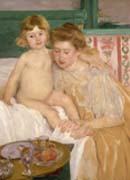
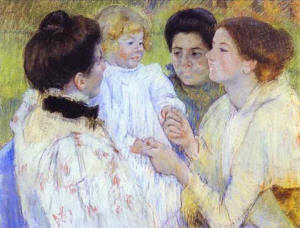
Gustave Caillebotte was a friend of the Impressionists from the very first hour. He was rich, fond of art, and himself a painter of great merit who modestly kept hidden behind his comrades. His picture Les raboteurs de parquets made him formerly the butt of derision. To-day his work, at the Luxembourg Gallery seems hardly a fit pretext for so much controversy, but at that time much was considered as madness, that to our eyes appears quite natural. This picture is a study of oblique perspective and its curious ensemble of rising lines sufficed to provoke astonishment. The work is, moreover, grey and discreet in colour and has some qualities of fine light, but is on the whole not very interesting. Recently an exhibition of works by Caillebotte has made it apparent that this amateur was a misjudged painter. The still-life pictures in this exhibition were specially remarkable. But the name of Caillebotte was destined to reach the public only in connection with controversies and scandal. When he died, he left to the State a magnificent collection of objets-d'art and of old pictures, and also a collection of Impressionist works, stipulating that these two bequests should be inseparable. He wished by this means to impose the works of his friends upon the museums, and thus avenge their unjust neglect. The State accepted the two legacies, since the Louvre absolutely wanted to benefit by the ancient portion, in spite of the efforts of the Academicians who revolted against the acceptance of the modern part. On this occasion one could see how far the official artists were carried by their hatred of the Impressionists. A group of Academicians, professors at the Ecole des Beaux-Arts, threatened the minister that they would resign en masse. "We cannot," they wrote to the papers, "continue to teach an art of which we believe we know the laws, from the moment the State admits into the museums, where our pupils can see them, works which are the very negation of all we teach." A heated discussion followed in the press, and the minister boldly declared that Impressionism, good or bad, had attracted the attention of the public, and that it was the duty of the State to receive impartially the work of all the art movements; the public would know how to judge and choose; the Government's duty was not to influence them by showing them only one style of painting, but to remain in historic neutrality. Thanks to this clever reply, the Academicians, among whom M. Gérôme was the most rabid, resigned themselves to keeping their posts. A similar incident, less publicly violent, but equally strange, occurred on the occasion of the admission to the Luxembourg Gallery of the portrait of M. Whistler's mother, a masterpiece of which the gallery is proud to-day, and for which a group of writers and art lovers had succeeded in opening the way. It is difficult to imagine the degree of irritation and obstruction of the official painters against all the ideas of the new painting, and if it had only depended upon them, there can be no doubt that Manet and his friends would have died in total obscurity, not only banished from the Salons and museums, but also treated as madmen and robbed of the possibility of living by their work.
The Caillebotte collection was installed under conditions which the ill-will of the administrators made at least as deplorable as possible. The works were crowded into a small, badly lighted room, where it is absolutely impossible to see them from the distance required by the method of the division of tones, and the meanness of the opposition was such that, the pictures having been bequeathed without frames, the keeper was obliged to have recourse to the reserves of the Louvre, because he was refused the necessary credit for purchasing them. The collection is however beautiful and interesting. It does not represent Impressionism in all its brilliancy, since the works by which it is composed had been bought by Caillebotte at a time, when his friends were still far from having arrived at the full blossoming of their qualities. But some very fine things can at least be found there. Renoir is marvellously represented by the Moulin de la Galette, which is one of his masterpieces. Degas figures with seven beautiful pastels, Monet with some landscapes grand in style; Sisley and Pissarro appear scarcely to their advantage, and finally it is to be regretted, that Manet is only represented by a study in black in his first manner, the Balcony, which does not count among his best pictures, and the famous Olympia whose importance is more historical than intrinsic. The gallery has separately acquired a Young Girl in Ball Dress by Berthe Morisot, which is a delicate marvel of grace and freshness. And in the place of honour of the gallery is to be seen Fantin-Latour's great picture Hommage à Manet, in which the painter, seated before his easel, is surrounded by his friends; and this canvas may well be considered the emblem of the slow triumph of Impressionism, and of the amends for a great injustice.
It is in this picture that the young painter Bazille is represented, a friend and pupil of Manet's, who was killed during the war of 1870, and who should not be forgotten here. He has left a few canvases marked by great talent, and would no doubt have counted among the most original contemporary artists. We shall terminate this all too short enumeration with two remarkable landscapists; the one is Albert Lebourg who paints in suave and poetic colour schemes, with blues and greens of particular tenderness, a painter who will take his place in the history of Impressionism. The other is Eugène Boudin. He has not adopted Claude Monet's technique; but I have already said that the vague and inexact term "Impressionism" must be understood to comprise a group of painters showing originality in the study of light and getting away from the academic spirit. As to this, Eugène Boudin deserves to be placed in the first rank. His canvases will be the pride of the best arranged galleries. He is an admirable seascape painter. He has known how to render with unfailing mastery, the grey waters of the Channel, the stormy skies, the heavy clouds, the effects of sunlight feebly piercing the prevailing grey. His numerous pictures painted at the port of Havre are profoundly expressive. Nobody has excelled him in drawing sailing-boats, in giving the exact feeling of the keels plunged into the water, in grouping the masts, in rendering the activity of a port, in indicating the value of a sail against the sky, the fluidity of calm water, the melancholy of the distance, the shiver of short waves rippled by the breeze. Boudin is a learned colourist of grey tones. His Impressionism consists in the exclusion of useless details, his comprehension of reflections, his feeling for values, the boldness of his composition and his faculty of directly perceiving nature and the transparency of atmosphere: he reminds sometimes of Constable and of Corot. Boudin's production has been enormous, and nothing that he has done is indifferent. He is one of those artists who have not a brilliant career, but who will last, and whose name, faithfully retained by the elect, is sure of immortality. He may be considered an isolated artist, on the border line between Classicism and Impressionism, and this is unquestionably the cause of the comparative obscurity of his fame. The same might be said of the ingenuous and fine landscapist Hervier, who has left such interesting canvases; and of the Lyons water-colour painter Ravier who, almost absolutely unknown, came very close to Monticelli and showed admirable gifts. It must, however, be recognised that Boudin is nearer to Impressionism than to any other grouping of artists, and he must be considered as a small master of pure French lineage. Finally, if a question of nationality prevents me from enlarging upon the subject of the rank of precursor which must be accorded to the great Dutch landscapist Jongkind, I must at least mention his name. His water-colour sketches have been veritable revelations for several Impressionists. Eugène Boudin and Berthe Morisot have derived special benefit from them, and they are valuable lessons for many young painters of the present day.
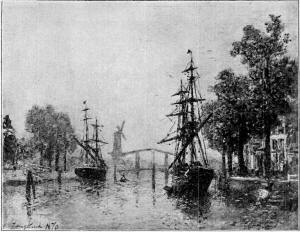
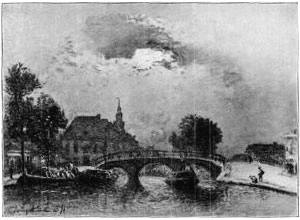
We do not pretend to have mentioned in this chapter all the painters directly connected with the first Impressionist movement. We have confined ourselves to enumerating the most important only, and each of them would deserve a complete essay. But our object will have been achieved, if we have inspired art-lovers with just esteem for this brave phalanx of artists who have proved better than any aesthetic commentaries the vitality, the originality, and the logic of Manet's theories, the great importance of the notions introduced by him into painting, and who have, on the other hand, clearly demonstrated the uselessness of official teaching. Far from the traditions and methods of the School, the best of their knowledge and of their talent is due to their profound and sincere contemplation of nature and to their freedom of spirit. And for that reason they will have a permanent place in the evolution of their art.
Not the least important result of Impressionism has been the veritable revolution effected by it in the art of illustration. It was only natural that its principles should have led to it. The substitution of the beauty of character for the beauty of proportion was bound to move the artists to regard illustration in a new light; and as pictorial Impressionism was born of the same movement of ideas which created the naturalist novel and the impressionist literature of Flaubert, Zola and the Goncourts, and moreover as these men were united by close relations and a common defence, Edouard Manet's modern ideas soon took up the commentary of the books dealing with modern life and the description of actual spectacles.
The Impressionists themselves have not contributed towards illustration. Their work has consisted in raising to the style of grand painting subjects, that seemed at the best only worthy of the proportion of vignettes, in opposition to the subjects qualified as "noble" by the School. The series of works by Manet and Degas may be considered as admirable illustrations to the novels by Zola and the Goncourts. It is a parallel research in modern psychologic truth. But this research has remained confined to pictures. It may be presumed that, had they wished to do so, Manet and Degas could have admirably illustrated certain contemporary novels, and Renoir could have produced a masterpiece in commenting, say, upon Verlaine's Fêtes Galantes. The only things that can be mentioned here are a few drawings composed by Manet for Edgar A. Poe's The Raven and Mallarmé's L'Après-Midi d'un Faune, in addition to a few music covers without any great interest.
But if the Impressionists themselves have neglected actively to assist the interesting school of modern illustration, a whole legion of draughtsmen have immediately been inspired by their principles. One of their most original characteristics was the realistic representation of the scenes, the mise en cadre, and it afforded these draughtsmen an opportunity for revolutionising book illustration. There had already been some excellent artists who occupied themselves with vignette drawings, like Tony Johannot and Célestin Nanteuil, whose pretty and smart frontispieces are to be found in the old editions of Balzac. The genius of Honoré Daumier and the high fancy of Gavarni and of Grévin had already announced a serious protest of modern sentiment against academic taste, in returning on many points to the free tradition of Eisen, of the two Moreaus and of Debucourt. Since 1845 the draughtsman Constantin Guys, Baudelaire's friend, gave evidence, in his most animated water-colour drawings, of a curious vision of nervous elegance and of expressive skill quite in accord with the ideas of the day. Impressionism, and also the revelation of the Japanese colour prints, gave an incredible vigour to these intuitive glimpses. Certain characteristics will date from the days of Impressionism. It is due to Impressionism that artists have ventured to show in illustration, for instance, figures in the foreground cut through by the margin, rising perspectives, figures in the background that seem to stand on a higher plane than the others, people seen from a second story; in a word, all that life presents to our eyes, without the annoying consideration for "style" and for arrangement, which the academic spirit obstinately insisted to apply to the illustration of modern life. Degas in particular has given many examples of this novelty in composition. One of his pastels has remained typical, owing to the scandal caused by it: he represents a dance-scene at the Opera, seen from the orchestra. The neck of a double bass rises in the middle of the picture and cuts into it, a large black silhouette, behind which sparkle the gauze-dresses and the lights. That can be observed any evening, and yet it would be difficult to recapitulate all the railleries and all the anger caused by so natural an audacity. Modern illustration was to be the pretext of a good many more outbursts!
We must now consider four artists of great importance who are remarkable painters and have greatly raised the art of illustration. This title illustrator, despised by the official painters, should be given them as the one which has secured them the best claim to fame. They have restored to this title all its merit and all its brilliancy and have introduced into illustration the most serious qualities of painting. Of these four men the first in date is M.J.F. Raffaëlli, who introduced himself about 1875 with some remarkable and intensely picturesque illustrations in colours in various magazines. He gave an admirable series of Parisian Types, in album form, and a series of etchings to accompany the text of M. Huysmans, describing the curious river "la Bièvre" which penetrates Paris in a thousand curves, sometimes subterranean, sometimes above ground, and serves the tanners for washing the leather. This series is a model of modern illustration. But, apart from the book, the entire pictorial work of M. Raffaëlli is a humorous and psychological illustration of the present time. He has painted with unique truth and spirit the working men's types and the small bourgeois, the poor, the hospital patients and the roamers of the outskirts of Paris. He has succeeded in being the poet of the sickly and dirty landscapes by which the capitals are surrounded; he has rendered their anaemic charm, the confused perspectives of houses, fences, walls and little gardens, and their smoke, under the melancholy of rainy skies. With an irony free from bitterness he has noted the clumsy gestures of the labourer in his Sunday garb and the grotesque silhouettes of the small townsmen, and has compiled a gallery of very real sociologic interest. M. Raffaëlli has also exhibited Parisian landscapes in which appear great qualities of light. He excels in rendering the mornings in the spring, with their pearly skies, their pale lights, their transparency and their slight shadows, and finally he has proved his mastery by some large portraits, fresh harmonies, generally devoted to the study of different qualities of white. If the name "Impressionist" meant, as has been wrongly believed, an artist who confines himself to giving the impression of what he sees, then M. Raffaëlli would be the real Impressionist. He suggests more than he paints. He employs a curious technique: he often leaves a sky completely bare, throwing on to the white of the canvas a few colour notes which suffice to give the illusion. He has a decided preference for white and black, and paints very slightly in small touches. His very correct feeling for values makes him an excellent painter; but what interests him beyond all, is psychologic expression. He notes it with so hasty a pencil, that one might almost say that he writes with colour. He is also an etcher of great merit, and an original sculptor. He has invented small bas-reliefs in bronze which can be attached to the wall, like sketches or nick-nacks; and he has applied his talent even to renewing the material for painting. He is an ingenious artist and a prolific producer, a roguish, but sympathetic, observer of the life of the small people, which has not prevented him from painting very seriously when he wanted to, as is witnessed among other works by his very fine portrait of M. Clemenceau speaking at a public meeting, in the presence of a vociferous audience from which rise some hundred of heads whose expressions are noted with really splendid energy and fervour.
Henri de Toulouse-Lautrec, who died recently, insane, leaves a great work behind him. He had a kind of cruel genius. Descended from one of the greatest families of France, badly treated by nature who made him a kind of ailing dwarf, he seemed to take a bitter pleasure in the study of modern vice. He painted scenes at café-concerts and the rooms of wantons with intense truth. Nobody has revealed better than he the lowness and suffering of the creatures "of pleasure," as they have been dubbed by the heartrending irony of life. Lautrec has shown the artificiality of the painted faces; the vulgarity of the types of the prostitutes of low origin; the infamous gestures, the disorder, the slovenliness of the dwellings of these women; all the shady side of their existence. It has been said that he loved ugliness. As a matter of fact, he did not exaggerate, he raised a powerful accusation against everything he saw. But his terrible clairvoyance passed for caricature. This sad psychologist was a great painter; he pleased himself with dressing in rose-coloured costumes the coarsest and most vulgar creatures he painted, such as one can find at the cabarets and concerts, and he enjoyed the contrast of fresh tones with the faces marked by vice and poverty; Lautrec's two great influences have been the Japanese and Degas. Of the former he retained the love for decorative arabesques and the unconventional grouping; of the other the learned draughtsmanship, expressive in its broad simplification, and one might say that the pupil has often been worthy of the masters. One can only regret that Lautrec should have confined his vision and his high faculties to the study of a small and very Parisian world; but, seeing his works, one cannot deny the science, the spirit and the grand bearing of his art. He has also signed some fine posters, notably a Bruant which is a masterpiece of its kind.
Degas's deep influence can be found again in J.L. Forain, who has made himself known by an immense series of drawings for the illustrated papers, drawings as remarkable in themselves as they are, through their legends, bitterly sarcastic in spirit. These drawings form a synthesis of the defects of the bourgeoisie, which is at the same time amusing and grave. They also concern, though less happily, the political world, in which the artist, a little intoxicated with his success, has thought himself able to exercise an influence by scoffing at the parliamentary régime. Forain's drawing has a nervous character which does, however, not weaken its science: every stroke reveals something and has an astonishing power. In his less known painting can be traced still more clearly the style and influence of his master Degas. They are generally incidents behind the scenes and at night restaurants, where caricatured types are painted with great force. But they are insistently exaggerated, they have not the restraint, the ironical and discreet plausibility, which give so much flavour, so much value to Degas's studies. Nevertheless, Forain's pictures are very significant and are of real interest. He is decidedly the most interesting newspaper illustrator of his whole generation, the one whose ephemeral art most closely approaches grand painting, and one of those who have most contributed towards the transformation of illustration for the contemporary press.
Jules Chéret has made for himself an important and splendid position in contemporary art. He commenced as a lithographic workman and lived for a long time in London. About 1870 Chéret designed his first posters in black, white and red; these were at the time the only colours used. By and by he perfected this art and found the means of adding other tones and of drawing them on the lithographic stone. He returned to France, started a small studio, and gradually carried poster art to the admirable point at which it has arrived. At the same time Chéret drew and painted and composed himself his models. About 1885 his name became famous, and it has not ceased growing since. Some writers, notably the eminent critic Roger Marx and the novelist Huysmans, hailed in Chéret an original artist as well as a learned technician. He then exhibited decorative pictures, pastels and drawings, which placed him in the first rank. Chéret is universally known. The type of the Parisian woman created by him, and the multi-coloured harmony of his works will not be forgotten. His will be the honour of having invented the artistic poster, this feast for the eyes, this fascinating art of the street, which formerly languished in a tedious and dull display of commercial advertisements. He has been the promoter of an immense movement; he has been imitated, copied, parodied, but he will always remain inimitable. He has succeeded in realising on paper by means of lithography, the pastels and gouache drawings in which his admirable colourist's fancy mixed the most difficult shades. In Chéret can be found all the principles of Impressionism: opposing lights, coloured shadows, complementary reflections, all employed with masterly sureness and delightful charm. It is decorative Impressionism, conceived in a superior way; and this simple poster-man, despised by the painters, has proved himself equal to most. He has transformed the street, in the open light, into a veritable Salon, where his works have become famous. When this too modest artist decided to show his pictures and drawings, they were a revelation. The most remarkable pastellists of the period were astonished and admired his skill, his profound knowledge of technique, his continual tours-de-force which he disguised under a shimmering gracefulness. The State had the good sense to entrust him with some large mural decorations, in which he unfolded the scale of his sparkling colours, and affirmed his spirit, his fancy and his dreamy art. Chéret's harmonies remain secrets; he uses them for the representation of characters from the Italian comedy, thrown with fiendish verve upon a background of a sky, fiery with the Bengal lights of a fairy-like carnival, and he strangely intermingles the reality of the movements with the most arbitrary fancy. Chéret has also succeeded in proving his artistic descent by a beautiful series of drawings in sanguine: he descends from Watteau, Boucher and Fragonard; he is a Frenchman of pure blood; and when one has done admiring the grace and the happy animation of his imagination, one can only be surprised to see on what serious and sure a technique are based these decorations which appear improvised. Chéret's art is the smile of Impressionism and the best demonstration of the decorative logic of this art.
These are the four artists of great merit who have created the transition between Impressionist painting and illustration. It would be fit to put aside Toulouse-Lautrec, who was much younger, but his work is too directly connected with that of Degas for one to take into account the difference of age. He produced between 1887 and 1900 works which might well have been ante-dated by fifteen years. We shall study in the next chapter his Neo-Impressionist comrades, and we shall now speak of some illustrators more advanced in years than he. The oldest in date is the engraver Henri Guérard, who died three years ago. He had married Eva Gonzalès and was a friend of Manet's, many of whose works have been engraved by him. He was an artist of decided and original talent, who also occupied himself successfully with pyrogravure, and who was happily inspired by the Japanese colour-prints. His etchings deserve a place of honour in the folios of expert collectors; they are strong and broad. As to the engraver Félix Buhot, he was a rather delicate colourist in black and white; his Paris scenes will always be considered charming works. In spite of his Spanish origin, the painter, aquarelliste, and draughtsman Daniel Vierge, should be added to the list of the men connected with Impressionism. His illustrations are those of a great artist—admirable in colour, movement and observation; all the great principles of Impressionism are embodied in them. But there are four more illustrators of the first rank: Steinlen, Louis Legrand, Paul Renouard and Auguste Lepère.
Steinlen has been enormously productive: he is specially remarkable for his illustrations. Those which he has designed for Aristide Bruant's volume of songs, Dans la rue, are masterpieces of their kind. They contain treasures of bitter observation, quaintness and knowledge. The soul of the lower classes is shown in them with intense truth, bitter revolt and comprehensive philosophy. Steinlen has also designed some beautiful posters, pleasing pastels, lithographs of incontestable technical merit, and beautifully eloquent political drawings. It cannot be said that he is an Impressionist in the strict sense of the word; he applied his colour in flat tints, more like an engraver than a painter; but in him too can be felt the stamp of Degas, and he is one of those who best demonstrate that, without Impressionism, they could not have been what they are.
The same may be said of Louis Legrand, a pupil of Félicien Rops, an admirably skilful etcher, a draughtsman of keen vision, and a painter of curious character, who has in many ways forestalled the artists of to-day. Louis Legrand also shows to what extent the example of Manet and Degas has revolutionised the art of illustration, in freeing the painters from obsolete laws, and guiding them towards truth and frank psychological study. Legrand is full of them, without resembling them. We must not forget that, besides the technical innovation (division of tones, study of complementary colours), Impressionism has brought us novelty of composition, realism of character and great liberty in the choice of subjects. From this point of view Rops himself, in spite of his symbolist tendencies, could not be classed with any other group, if it were not that any kind of classification in art is useless and inaccurate. However that may be, Louis Legrand has signed some volumes resplendent with the most seductive qualities.
Paul Renouard has devoted himself to newspaper illustration, but with what surprising prodigality of spirit and knowledge! The readers of the "Graphic" will know. This masterly virtuoso of the pencil might give drawing-lessons to many members of the Institute! The feeling for the life of crowds, psychology of types, spirited and rapid notation, astonishing ease in overcoming difficulties—these are his undeniable gifts. And again we must recognise in Renouard the example of Degas and Manet. His exceptional fecundity only helps to give more authority to his pencil. Renouard's drawings at the Exhibition of 1900 were, perhaps, more beautiful than the rest of his work. There was notably a series of studies made from the first platform of the Eiffel Tower, an accumulation of wonders of perspectives framing scenes of such animation and caprice as to take away one's breath.
Finally, Auguste Lepère appears as the Debucourt of our time. As painter, pastellist and wood-engraver he has produced since 1870, and has won for himself the first place among French engravers. It would be difficult to recount the volumes, albums and covers on which the fancy of his burin has played; but it is particularly in wood-engraving that he stands without rival. Not only has he produced masterpieces of it, but he has passionately devoted himself to raising this admirable art, the glory of the beautiful books of olden days, and to give back to it the lustre which had been eclipsed by mechanical processes. Lepère has started some publications for this purpose; he has had pupils of great merit, and he must be considered the master of the whole generation of modern wood-engravers, just as Chéret is the undisputed master of the poster. Lepère's ruling quality is strength. He seems to have rediscovered the mediaeval limners' secrets of cutting the wood, giving the necessary richness to the ink, creating a whole scale of half-tones, and specially of adapting the design to typographic printing, and making of it, so to say, an ornament and a decorative extension for the type. Lepère is a wood-engraver with whom none of his contemporaries can be compared; as regards his imagination, it is that of an altogether curious artist. He excels in composing and expressing the life, the animation, the soul of the streets and the picturesque side of the populace. Herein he is much inspired by Manet and, if we go back to the real tradition, by Guys, Debucourt, the younger Moreau and by Gabriel de Saint-Aubin. He is decidedly a Realist of French lineage, who owes nothing to the Academy and its formulas.
It would be evidently unreasonable to attach to Impressionism all that is ante-academical, and between the two extremes there is room for a crowd of interesting artists. We shall not succumb to the prejudice of the School by declaring, in our turn, that there is no salvation outside Impressionism, and we have been careful to state repeatedly that, if Impressionism has a certain number of principles as kernel, its applications and its influence have a radiation which it is difficult to limit. What can be absolutely demonstrated is, that this movement has had the greatest influence on modern illustration, sometimes through its colouring, sometimes simply through the great freedom of its ideas. Some have found in it a direct lesson, others an example to be followed. Some have met in it technical methods which pleased them, others have only taken some suggestions from it. That is the case, for instance, with Legrand, with Steinlen, and with Renouard; and it is also the case with the lithographer Odilon Redon, who applies the values of Manet and, in his strange pastels, the harmonies of Degas and Renoir, placing them at the service of dreams and hallucinations and of a symbolism which is absolutely removed from the realism of these painters. It is, finally, the case with the water-colour painter Henri Rivière, who is misjudged as to his merit, and who is one of the most perfect of those who have applied Impressionist ideas to decorative engraving. He has realised images in colours destined to decorate inexpensively the rooms of the people and recalling the grand aspects of landscapes with a broad simplification which is derived, curiously enough, from Puvis de Chavannes's large decorative landscapes and from the small and precise colour prints of Japan. Rivière, who is a skilful and personal poetic landscapist, is not exactly an Impressionist, in so far as he does not divide the tones, but rather blends them in subtle mixtures in the manner of the Japanese. Yet, seeing his work, one cannot help thinking of all the surprise and freedom introduced into modern art by Impressionism.
Everybody, even the ignorant, can perceive, on looking through an illustrated paper or a modern volume, that thirty years ago this manner of placing the figures, of noting familiar gestures, and of seizing fugitive life with spirit and clearness was unknown. This mass of engravings and of sketches resembles in no way what had been seen formerly. They no longer have the solemn air of classic composition, by which the drawings had been affected. A current of bold spontaneity has passed through here. In modern English illustration, it can be stated indisputably that nothing would be such as it can now be seen, if Morris, Rossetti and Crane had not imposed their vision, and yet many talented Englishmen resemble these initiators only very remotely. It is exactly in this sense that we shall have credited Impressionism with the talents who have drawn their inspiration less from its principles, than from its vigorous protest against mechanical formulas, and who have been able to find the energy, necessary for their success, in the example it set by fighting during twenty years against the ideas of routine which seemed indestructible. Even with the painters who are far removed from the vision and the colouring of Manet and Degas, of Monet and Renoir, one can find a very precise tendency: that of returning to the subjects and the style of the real national tradition; and herein lies one of the most serious benefits bestowed by Impressionism upon an art which had stopped at the notion of a canonical beauty, until it had almost become sterile in its timidity.
The beginnings of the movement designated under the name of Neo-Impressionism can be traced back to about 1880. The movement is a direct offshoot of the first Impressionism, originated by a group of young painters who admired it and thought of pushing further still its chromatic principles. The flourishing of Impressionism coincided, as a matter of fact, with certain scientific labours concerning optics. Helmholtz had just published his works on the perception of colours and sounds by means of waves. Chevreul had continued on this path by establishing his beautiful theories on the analysis of the solar spectrum. M. Charles Henry, an original and remarkable spirit, occupied himself in his turn with these delicate problems by applying them directly to aesthetics, which Helmholtz and Chevreul had not thought of doing. M. Charles Henry had the idea of creating relations between this branch of science and the laws of painting. As a friend of several young painters he had a real influence over them, showing them that the new vision due to the instinct of Monet and of Manet might perhaps be scientifically verified, and might establish fixed principles in a sphere where hitherto the laws of colouring had been the effects of individual conception. At that moment the criticism which resulted from Taine's theories tried to effect a rapprochement of the artistic and scientific domains in criticism and in the psychologic novel. The painters, too, gave way to this longing for precision which seems to have been the great preoccupation of intellects from 1880 to about 1889.
Their researches had a special bearing on the theory of complementary colours and on the means of establishing some laws concerning the reaction of tones in such manner as to draw up a kind of tabula. Georges Seurat and Paul Signac were the promoters of this research. Seurat died very young, and one cannot but regret this death of an artist who would have been very interesting and capable of beautiful works. Those which he has left us bear witness to a spirit very receptive to theories, and leaving nothing to chance. The silhouettes are reduced to almost rigorously geometrical principles, the tones are decomposed systematically. These canvases are more reasoned examples than works of intuition and spontaneous vision. They show Seurat's curious desire to give a scientific and classic basis to Impressionism. The same idea rules in all the work of Paul Signac, who has painted some portraits and numerous landscapes. To these two painters is due the method of Pointillism, i.e. the division of tones, not only by touches, as in Monet's pictures, but by very small touches of equal size, causing the spheric shape to act equally upon the retina. The accumulation of these luminous points is carried out over the entire surface of the canvas without thick daubs of paint, and with regularity, whilst with Manet the paint is more or less dense. The theory of complementary colours is systematically applied. On a sketch, made from nature, the painter notes the principal relations of tones, then systematises them on his picture and connects them by different shades which should be their logical result. Neo-Impressionism believes in obtaining thus a greater exactness than that which results from the individual temperament of the painter who simply relies on his own perception. And it is true, in theory, that such a conception is more exact. But it reduces the picture to a kind of theorem, which excludes all that constitutes the value and charm of an art, that is to say: caprice, fancy, and the spontaneity of personal inspiration. The works of Seurat, Signac, and of the few men who have strictly followed the rules of Pointillism are lacking in life, in surprise, and make a somewhat tiring impression upon one's eyes. The uniformity of the points does not succeed in giving an impression of cohesion, and even less a suggestion of different textures, even if the values are correct. Manet seems to have attained perfection in using the method which consists in directing the touches in accordance with each of the planes, and this is evidently the most natural method. Scientific Chromatism constitutes an ensemble of propositions, of which art will be able to make use, though indirectly, as information useful for a better understanding of the laws of light in presence of nature. What Pointillism has been able to give us, is a method which would be very appreciable for decorative paintings seen from a great distance—friezes or ceilings in spacious buildings. It would in this case return to the principle of mosaic, which is the principle par excellence of mural art.
The Pointillists have to-day almost abandoned this transitional theory which, in spite of the undeniable talent of its adepts, has only produced indifferent results as regards easel pictures. Besides Seurat and Signac, mention should be made of Maurice Denis, Henri-Edmond Cross, Angrand, and Théo Van Rysselberghe. But this last-named and Maurice Denis have arrived at great talent by very different merits. M. Maurice Denis has abandoned Pointillism a few years ago, in favour of returning to a very strange conception which dates back to the Primitives, and even to Giotto. He simplifies his drawing archaically, suppresses all but the indispensable detail, and draws inspiration from Gothic stained glass and carvings, in order to create decorative figures with clearly marked outlines which are filled with broad, flat tints. He generally treats mystic subjects, for which this special manner is suitable. One cannot love the parti pris of these works, but one cannot deny M. Denis a great charm of naivete, an intense feeling for decorative arrangements and colouring of a certain originality. He is almost a French pre-Raphaelite, and his profound catholic faith inspires him nobly.
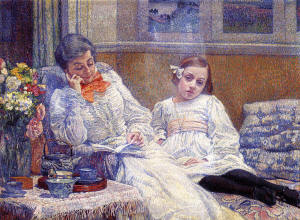
M. Théo Van Rysselberghe continues to employ the Pointillist method. But he is so strongly gifted, that one might almost say he succeeds in revealing himself as a painter of great merit in spite of this dry and charmless method. All his works are supported by broad and learned drawing and his colour is naturally brilliant. M. Van Rysselberghe, a prolific and varied worker, has painted nudes, large portraits, landscapes with figures, seascapes, interiors and still-life, and in all this he evinces faculties of the first order. He is a lover of light and understands how to make it vibrate over flesh and fabrics. He is an artist who has the sense of style. He has signed a certain number of portraits, whose beautiful carriage and serious psychology would suffice to make him be considered as the most significant of the Neo-Impressionists. It is really in him that one has to see the young and worthy heir of Monet, of Sisley, and of Degas, and that is why we have insisted on adding here to the works of these masters the reproduction of one of his. M. Van Rysselberghe is also a very delicate etcher who has signed some fine works in this method, and his seascapes, whether they revel in the pale greys of the German Ocean or in the warm sapphire and gold harmonies of the Mediterranean, count among the finest of the time; they are windows opened upon joyous brightness.
To these painters who have never taken part at the Salons, and are only to be seen at the exhibitions of the Indépendants (except M. Denis), must be added M. Pierre Bonnard, who has given proof to his charm and fervour in numerous small canvases of Japanese taste; and M. Edouard Vuillard, who is a painter of intimate scenes of rare delicacy. This artist, who stands apart and produces very little, has signed some interiors of melancholic distinction and of a colouring which revels in low tones. He has the precision and skill of a master. There is in him, one might say, a reflection of Chardin's soul. Unfortunately his works are confined to a few collections and have not become known to the public. To the same group belong M. Ranson, who has devoted himself to purely decorative art, tapestry, wall papers and embroideries; M. Georges de Feure, a strange, symbolist water-colour painter, who has become one of the best designers of the New Art in France; M. Félix Vallotton, painter and lithographer, who is somewhat heavy, but gifted with serious qualities. It is true that M. de Feure is Dutch, M. Vallotton Swiss, and M. Van Rysselberghe Belgian; but they have settled down in France, and are sufficiently closely allied to the Neo-Impressionist movement so that the question of nationality need not prevent us from mentioning them here. Finally it is impossible not to say a few words about two pupils of Gustave Moreau's, who have both become noteworthy followers of Impressionism of very personal individuality. M. Eugène Martel bids fair to be one of the best painters of interiors of his generation. He has the feeling of mystical life and paints the peasantry with astonishing psychologic power. His vigorous colouring links him to Monticelli, and his drawing to Degas. As to M. Simon Bussy who, following Alphonse Legros's example, is about to make an enviable position for himself in England, he is an artist of pure blood. His landscapes and his figures have the distinction and rare tone of M. Whistler, besides the characteristic acuteness of Degas. His harmonies are subtle, his vision novel, and he will certainly develop into an important painter. Together with Henri le Sidaner and Jacques Blanche, Simon Bussy is decidedly the most personal of that young generation of "Intimists" who seem to have retained the best principles of the Impressionist masters to employ them for the expression of a psychologic ideal which is very different from Realism.
Outside this group there are still a few isolated painters who are difficult to classify. The very young artists Laprade and Charles Guérin have shown for the last three years, at the exhibition of the Indépendants, some works which are the worthy result of Manet's and Renoir's influence. They, too, justify great expectations. The landscapists Paul Vogler and Maxime Maufra, more advanced in years, have made themselves known by some solid series of vigorously presented landscapes. To them must be added M. Henry Moret, M. Albert André and M. Georges d'Espagnet, who equally deserve the success which has commenced to be their share. But there are some older ones. It is only his due, that place should be given to a painter who committed suicide after an unhappy life, and who evinced splendid gifts. Vincent Van Gogh, a Dutchman, who, however, had always worked in France, has left to the world some violent and strange works, in which Impressionism appears to have reached the limits of its audacity. Their value lies in their naïve frankness and in the undauntable determination which tried to fix without trickery the sincerest feelings. Amidst many faulty and clumsy works, Van Gogh has also left some really beautiful canvases. There is a deep affinity between him and Cézanne. A very real affinity exists, too, between Paul Gauguin, who was a friend and to a certain extent the master of Van Gogh, and Cézanne and Renoir. Paul Gauguin's robust talent found its first motives in Breton landscapes, in which the method of colour-spots can be found employed with delicacy and placed at the service of a rather heavy, but very interesting harmony. Then the artist spent a long time in Tahiti, whence he returned with a completely transformed manner. He has brought back from these regions some landscapes with figures treated in intentionally clumsy and almost wild fashion. The figures are outlined in firm strokes and painted in broad, flat tints on canvas which has the texture almost of tapestry. Many of these works are made repulsive by their aspect of multi-coloured, crude and barbarous imagery. Yet one cannot but acknowledge the fundamental qualities, the beautiful values, the ornamental taste, and the impression of primitive animalism. On the whole, Paul Gauguin has a beautiful, artistic temperament which, in its aversion to virtuosoship, has perhaps not sufficiently understood that the fear of formulas, if exaggerated, may lead to other formulas, to a false ignorance which is as dangerous as false knowledge. Gauguin's symbolical intentions, like those of his pupil Emile Bernard, are sincere, but are badly served by minds which do not agree with their technical qualities, and both Gauguin and Emile Bernard are most happily inspired when they are painters pure and simple.
Next to Gauguin, among the seniors of the present generation and the successors of Impressionism, should be placed the landscapist Armand Guillaumin who, without possessing Sisley's delicate qualities, has painted some canvases worthy of notice; and we must, finally, terminate this far too summary enumeration by referring to one of the most gifted painters of the French School of the day, M. Louis Anquetin. His is a most varied talent whose power is unquestionable. He made his début among the Neo-Impressionists and revealed the influence upon him of the Japanese and of Degas. It may be seen that these two influences predominate in the whole group. Then M. Anquetin became fascinated by the breadth and superb freedom of Manet's works, and signed a series of portraits and sketches, some of which are not far below so great a master's. They are works which will surprise the critics, when our contemporary painting will be examined with calm impartiality. After these works, M. Anquetin gave way to his impetuous nature which led him to decorative painting, and he became influenced by Rubens, Jordaens, and the Fontainebleau School. He painted theatre curtains and mythological scenes, in which he gave free rein to his sensual imagination. In spite of some admirable qualities, it seems as though the artist had strayed from his true path in painting these brilliant, but somewhat declamatory works, and he has since returned to a more modern and more direct painting. In all his changed conditions Anquetin has shown a considerable talent, pleasing in its fine vigour, impetuosity, brilliancy and sincerity. His inequality is perhaps the cause of his relative want of success; it has put the public off, but nevertheless in certain of this brave and serious painter's canvases can be seen the happy influence of Manet.
It seems to us only right to sum up our impartial opinion of Neo-Impressionism by saying that it has lacked cohesion, that Pointillism in particular has led painting into an aimless path. It has been wrong to see in Impressionism too exclusive a pretext for technical researches, and a happy reaction has set in, which leads us back to-day, after diverse tentative efforts (amongst others some unfortunate attempts at symbolist painting), to the fine, recent school of the "Intimists" and to the novel conception which a great and glorious painter, Besnard, imposes upon the Salons, where the elect draw inspiration from him. We can here only indicate with a few words the considerable part played by Besnard: his clever work has proved that the scientific colour principles of Impressionism may be applied, not to realism, but to the highest thoughts, to ideologic painting most nobly inspired by the modern intellectual preoccupations. He is the transition between Impressionism and the art of to-morrow. Of pure French lineage by his portraits and his nudes, which descend directly from Largillière and Ingres, he might have restricted himself to being placed among the most learned Impressionists. His studies of reflections and of complementary colours speak for this. But he has passed this phase and has, with his decorations, returned to the psychical domain of his strangely beautiful art. The "Intimists," C. Cottet, Simon, Blanche, Ménard, Bussy, Lobre, Le Sidaner, Wéry, Prinet, and Ernest Laurent, have proved that they have profited by Impressionism, but have proceeded in quite a different direction in trying to translate their real perceptions. Some isolated artists, like the decorative painter Henri Martin, who has enormous talent, have applied the Impressionist technique to the expression of grand allegories, rather in the manner of Puvis de Chavannes. The effort at getting away from mere cleverness and escaping a too exclusive preoccupation with technique, and at the same time acquiring serious knowledge, betrays itself in the whole position of the young French School; and this will furnish us with a perfectly natural conclusion, of which the following are the principal points:—
What we shall have to thank Impressionism for, will be moral and material advantages of considerable importance. Morally it has rendered an immense service to all art, because it has boldly attacked routine and proved by the whole of its work that a combination of independent producers could renew the aesthetic code of a country, without owing anything to official encouragement. It has succeeded where important but isolated creators have succumbed, because it has had the good fortune of uniting a group of gifted men, four of whom will count among the greatest French artists since the origin of national art. It has had the qualities which overcome the hardest resistance: fecundity, courage and sure originality. It has known how to find its strength by referring to the true traditions of the national genius, which have happily enlightened it and saved it from fundamental errors. It has, last, but not least, inflicted an irremediable blow on academic convention and has wrested from it the prestige of teaching which ruled tyrannically for centuries past over the young artists. It has laid a violent hand upon a tenacious and dangerous prejudice, upon a series of conventional notions which were transmitted without consideration for the evolution of modern life and intelligence. It has dared freely to protest against a degenerated ideal which vainly parodied the old masters, pretending to honour them. It has removed from the artistic soul of France a whole order of pseudo-classic elements which worked against its blossoming, and the School will never recover from this bold contradiction which has rallied to it all the youthful. The moral principle of Impressionism has been absolutely logical and sane, and that is why nothing has been able to prevent its triumph.
Technically Impressionism has brought a complete renewal of pictorial vision, substituting the beauty of character for the beauty of proportions and finding adequate expression for the ideas and feelings of its time, which constitutes the secret of all beautiful works. It has taken up again a tradition and added to it a contemporary page. It will have to be thanked for an important series of observations as regards the analysis of light, and for an absolutely original conception of drawing. Some years have been wasted by painters of little worth in imitating it, and the Salons, formerly encumbered with academic pastiches, have been encumbered with Impressionist pastiches. It would be unfair to blame the Impressionists for it. They have shown by their very career that they hated teaching and would never pretend to teach. Impressionism is based upon irrefutable optic laws, but it is neither a style, nor a method, likely ever to become a formula in its turn. One may call upon this art for examples, but not for receipts. On the contrary, its best teaching has been to encourage artists to become absolutely independent and to search ardently for their own individuality. It marks the decline of the School, and will not create a new one which would soon become as fastidious as the other. It will only appear, to those who will thoroughly understand it, as a precious repertory of notes, and the young generation honours it intelligently by not imitating it with servility.
Not that it is without its faults! It has been said, to belittle it, that it only had the value of an interesting attempt, having only been able to indicate some excellent intentions, without creating anything perfect. This is inexact. It is absolutely evident, that Manet, Monet, Renoir and Degas have signed some masterpieces which did not lose by comparison with those in the Louvre, and the same might even be said of their less illustrious friends. But it is also evident that the time spent on research as well as on agitation and enervating controversies pursued during twenty-five years, has been taken from men who could otherwise have done better still. There has been a disparity between Realism and the technique of Impressionism. Its realistic origin has sometimes made it vulgar. It has often treated indifferent subjects in a grand style, and it has too easily beheld life from the anecdotal side. It has lacked psychologic synthesis (if we except Degas). It has too willingly denied all that exists hidden under the apparent reality of the universe and has affected to separate painting from the ideologic faculties which rule over all art. Hatred of academic allegory, defiance of symbolism, abstraction and romantic scenes, has led it to refuse to occupy itself with a whole order of ideas, and it has had the tendency of making the painter beyond all a workman. It was necessary at the moment of its arrival, but it is no longer necessary now, and the painters understand this themselves. Finally it has too often been superficial even in obtaining effects; it has given way to the wish to surprise the eyes, of playing with tones merely for love of cleverness. It often causes one regret to see symphonies of magnificent colour wasted here in pictures of boating men; and there, in pictures of café corners; and we have arrived at a degree of complex intellectuality which is no longer satisfied with these rudimentary themes. It has indulged in useless exaggerations, faults of composition and of harmony, and all this cannot be denied.
But it still remains fascinating and splendid for its gifts which will always rouse enthusiasm: freedom, impetuousness, youth, brilliancy, fervour, the joy of painting and the passion for beautiful light. It is, on the whole, the greatest pictorial movement that France has beheld since Delacroix, and it brings to a finish gloriously the nineteenth century, inaugurating the present. It has accomplished the great deed of having brought us again into the presence of our true national lineage, far more so than Romanticism, which was mixed with foreign elements. We have here painting of a kind which could only have been conceived in France, and we have to go right back to Watteau in order to receive again the same impression. Impressionism has brought us an almost unhoped-for renaissance, and this constitutes its most undeniable claim upon the gratitude of the race.
It has exercised a very appreciable influence upon foreign painting. Among the principal painters attracted by its ideas and research, we must mention, in Germany, Max Liebermann and Kuehl; in Norway, Thaulow; in Denmark, Kroyer; in Belgium, Théo Van Rysselberghe, Emile Claus, Verheyden, Heymans, Verstraete, and Baertson; in Italy, Boldini, Segantini, and Michetti; in Spain, Zuloaga, Sorolla y Bastida, Dario de Regoyos and Rusiñol; in America, Alexander, Harrison, Sargent; and in England, the painters of the Glasgow School, Lavery, Guthrie and the late John Lewis Brown. All these men come within the active extension of the French movement, and one may say that the honour of having first recognised the truly national movement of this art must be given to those foreign countries which have enriched their collections and museums with works that were despised in the land which had witnessed their birth. At the present moment the effects of this new vision are felt all over the world, down to the very bosom of the academies; and at the Salons, from which the Impressionists are still excluded, can be witnessed an invasion of pictures inspired by them, which the most retrograde juries dare not reject. In whatever measure the recent painters accept Impressionism, they remain preoccupied with it, and even those who love it not are forced to take it into account.
The Impressionist movement can therefore now be considered, apart from all controversies, without vain attacks or exaggerated praise, as an artistic manifestation which has entered the domain of history, and it can be studied with the impartial application of the methods of critical analysis which is usually employed in the study of the former art movements. We shall not pretend to have given in these pages a complete and faultless history; but we shall consider ourselves well rewarded for this work, which is intended to reach the great public, if we have roused their curiosity and sympathy with a group of artists whom we consider admirable; and if we have rectified, in the eyes of the readers of a foreign nation, the errors, the slanders, the undeserved reproaches, with which Frenchmen have been pleased to overwhelm sincere creators who thought with faith and love of the pure tradition of the national genius, and who have for that reason been vilified as much as if they had in an access of anarchical folly risen against the very common sense, taste, reason and clearness, which will remain the eternal merits of their soil. This small, imperfect volume will perhaps find its best excuse in its intention of repairing an old injustice and of affirming a useful and permanent truth: that of the authenticity of the classicism of Impressionism, in the face of the false classicism of the academic world which official honours have made the guardian of a French heritage, whose soul it denied and whose spirit it deceived with its narrow and cold formulas.
1 Who will deliver us from the Greeks and the Romans.
2 Procédé de la tache.